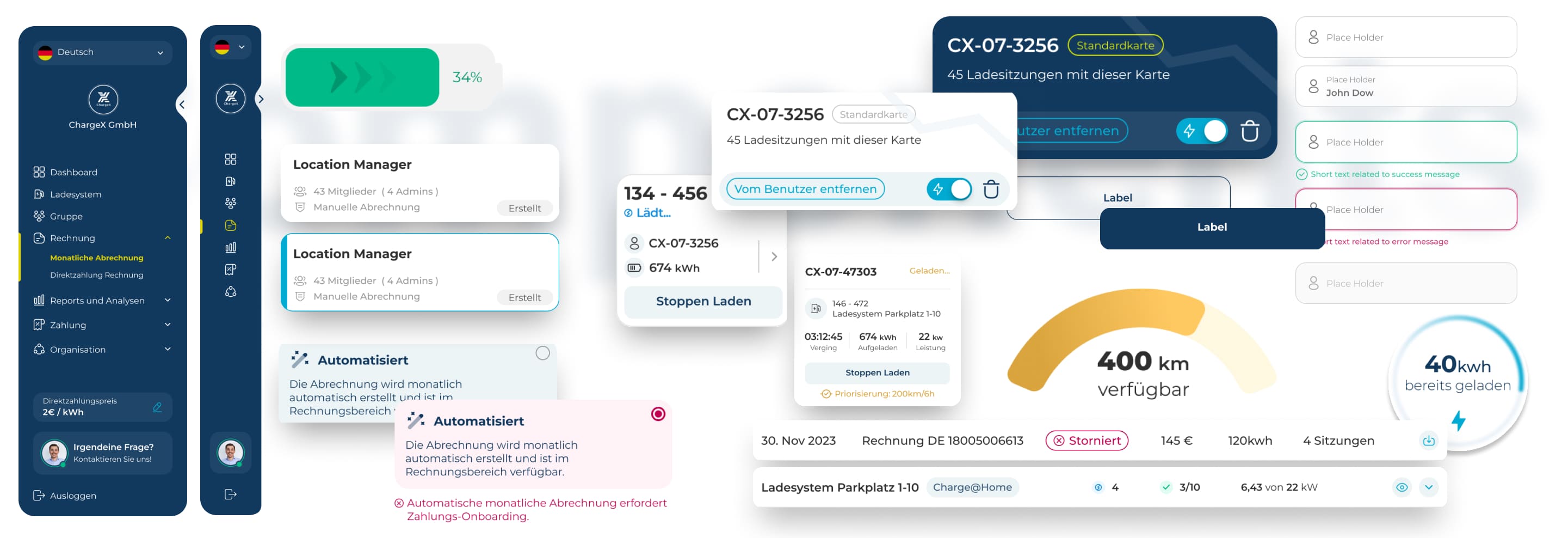How I Transformed ChargeX Dashboards to Serve Diverse Users and Enable Scalability
ChargeX is a German startup building modular, scalable EV charging solutions for fleets, residential buildings, and businesses. But as the customer base grew, the existing Admin Dashboard couldn’t keep up, it was rigid, outdated, and unable to serve the very different needs of admins. That’s where I came in. I led the end-to-end redesign and feature expansion of the dashboard: uncovering new customer groups, identifying key admin personas, and creating a scalable system built around real-world workflows.
Impact:
Customer Segments
Expanded with tailored dashboards
Sales Team
Strengthened with persona-specific solutions
Admin Workflows
Reduced from hours to minutes
Scalability
Enabled with future-ready foundation
Note: To respect NDA commitments, certain details in this case study have been blurred .
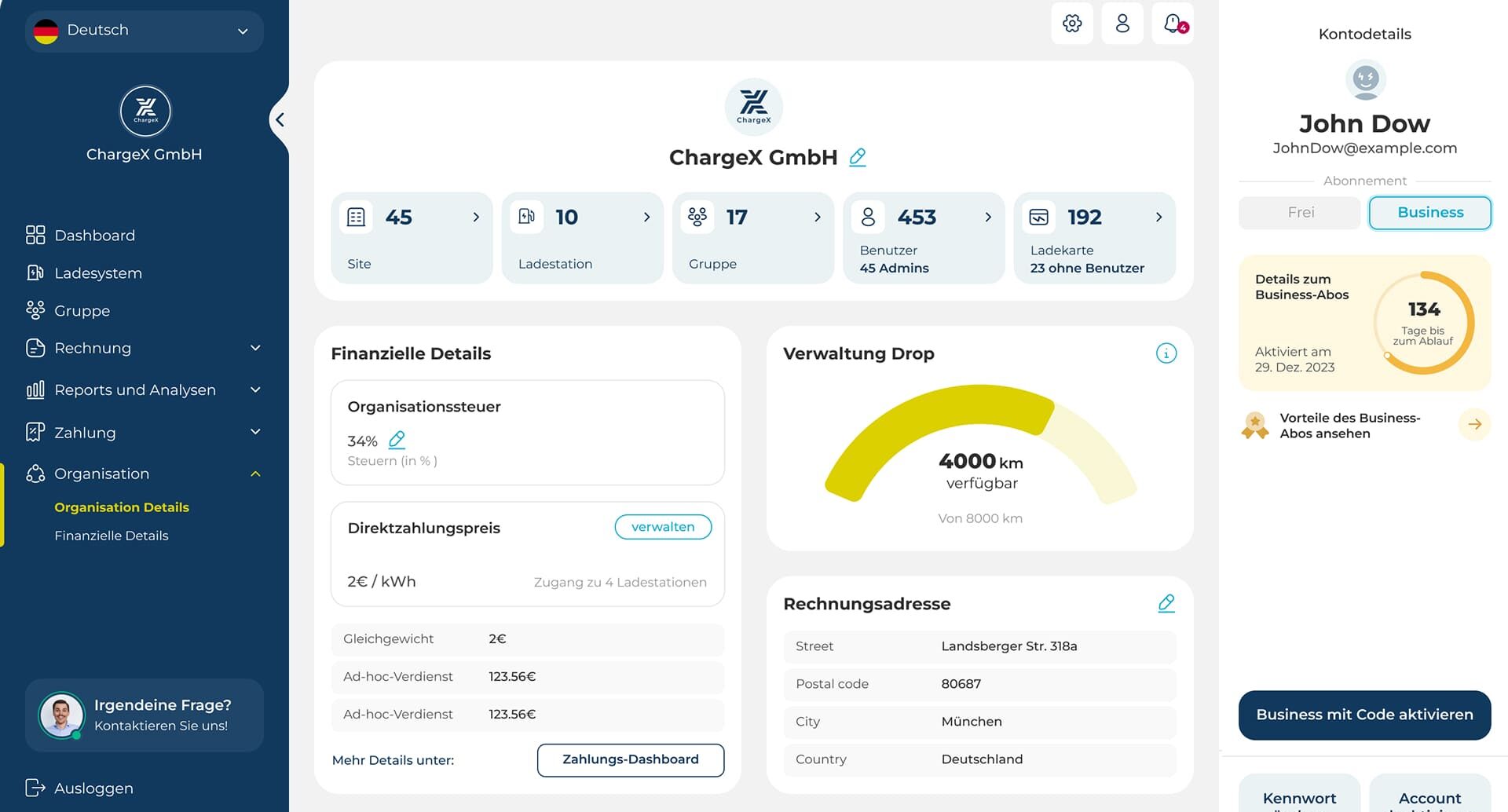
My Role
I led the end-to-end design of the ChargeX Admin Dashboard, from uncovering new customer groups and persona needs to designing core workflows, new features, and a scalable system. I focused on aligning user goals with business strategy, unlocking growth opportunities, and building a strong foundation for persona-specific dashboards.
Team
As the solo product designer, I worked closely with product managers and the dev lead to stay aligned on both strategy and execution. I also collaborated with stakeholders, customer success, and sales to validate ideas, shape direction, and ensure the dashboard supported real admin needs and business growth.
Industry
B2B SaaS | E-Mobility, Electric Vehicle Charging
Company
ChargeX GmbH | München, Germany
The Problem
The Old Dashboard Couldn’t Scale, Serve New Customer Groups, or Meet Evolving Needs
The existing Admin Dashboard, built six years ago, was rigid and outdated. It only fit one type of admin, leaving new customer groups like SMEs, fleets, and hotels without the features or workflows they needed. Critical gaps such as the lack of automated billing, scalable group management, and usable station monitoring made daily operations slow and frustrating. It was clear the dashboard had to be refactored from the ground up.
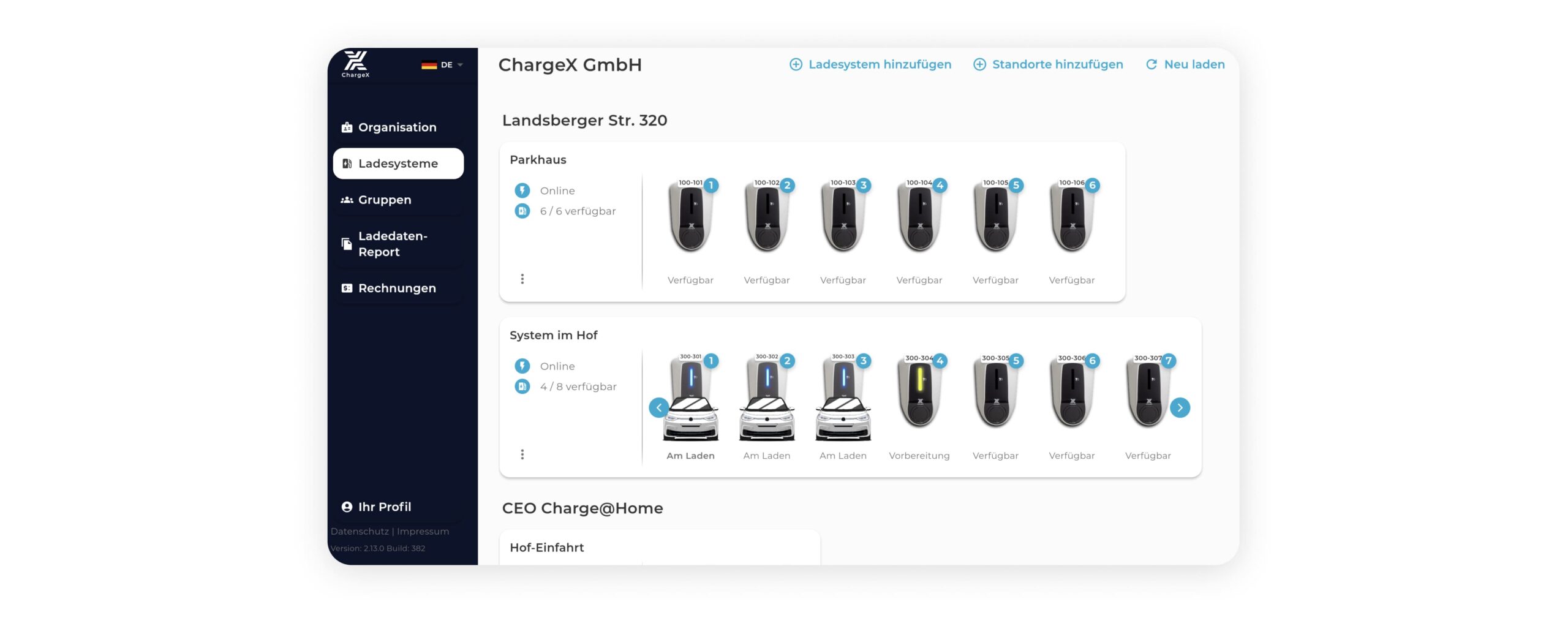
I Kicked Off the Project by Aligning on Business Evolving Needs Before Diving Into Research
Because this was a large-scale refactoring with new features driven by business policies, I knew that jumping straight into user research or UI work would be premature. For this project, I first needed to understand what the business wanted to achieve so I could make better design decisions later, and ask sharper questions when talking to users.
So I facilitated workshops with PMs and stakeholders to align on what the business needed to achieve.
The outcomes became the north star for everything that followed:
👥 Clear identification of distinct admin personas, along with their needs and expectations
With new customer groups (fleet managers, hotels, dealers, residential admins) emerging, I was asked to uncover their workflows, needs, and expectations so the redesigned dashboard could truly serve them.
💳 Seamless monthly billing flows (manual + automated) as a core feature
PMs wanted both manual and automated billing built into the dashboard, reducing reliance on support and giving admins full control over payments.
⚡ Scalable dashboard to support admins managing from 1 to 50+ organizations
Stakeholders asked me to ensure the system could handle anything from a single organization to 50+, so admins wouldn’t hit blockers as their operations grew.
👉 This gave me a clear, prioritized map of business needs, ensuring that when I later turned to user research, I wasn’t just uncovering pain points in isolation but grounding them in the company’s strategic direction.
🤓
With business goals clarified, my next step was to pinpoint the exact people this dashboard had to work for.
I Began by Identifying the People Behind the Dashboard Through Three Angles: Support Tickets, Interviews, Internal Workshops
The existing tool was built six years ago for a single admin type, but ChargeX had since grown into serving SMEs, fleet managers, residential admins, and hotels. Each had different workflows, yet the old dashboard treated them all the same. I knew guessing wouldn’t cut it, I needed evidence.
At first,
I Analyzed Support Tickets to Spot Patterns in Admin Needs in collaboration with CS Team
Together with the Customer Success team, I went back through one year of support ticketsto capture a holistic view of what admins were struggling with and, more importantly, what they expected the dashboard to help them achieve. Instead of treating tickets as isolated problems, I used them to look for recurring patterns in expectations, workflows, and frustrations
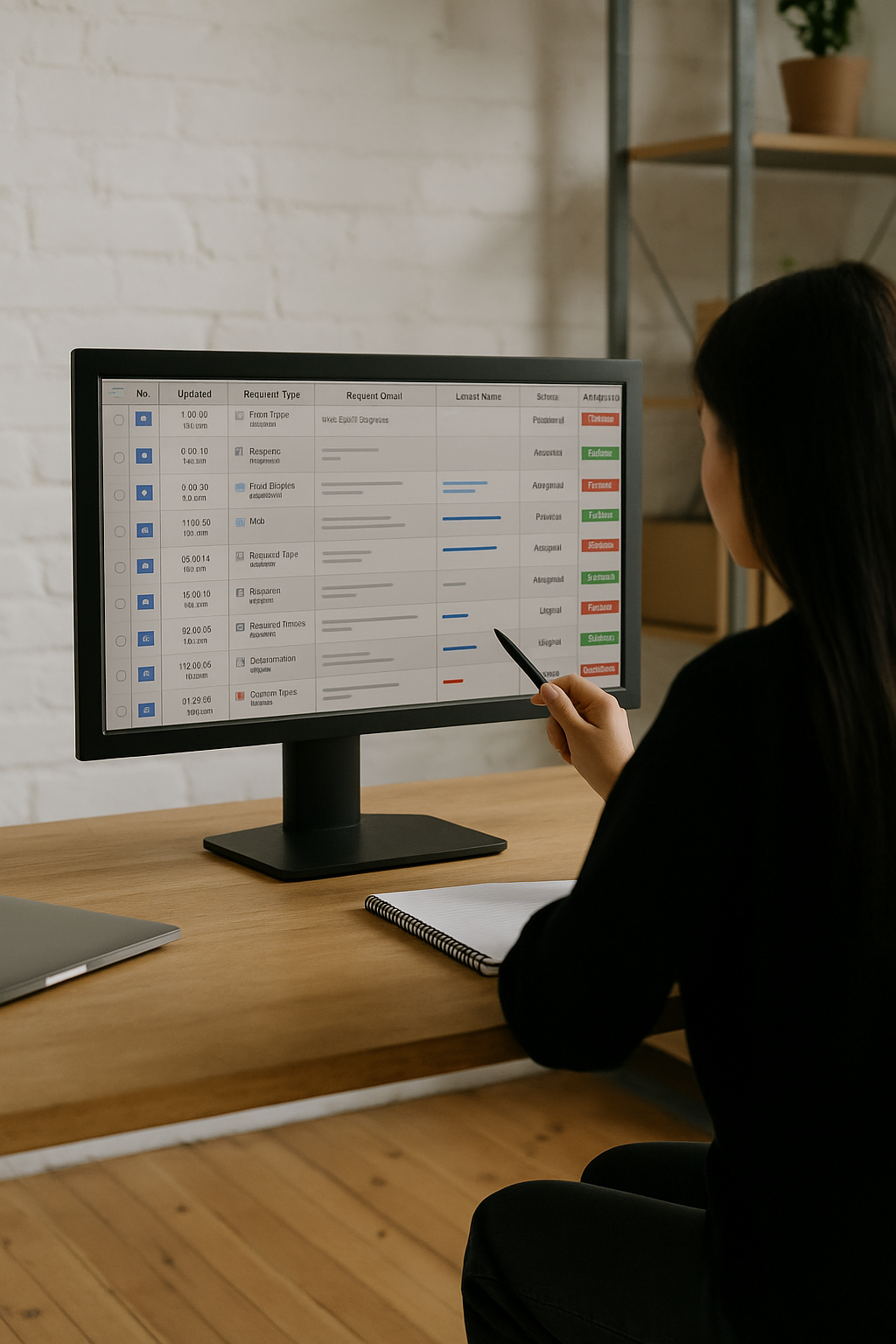
Some Admins Wanted Instant Visibility into Charging Activity
Many struggled to answer “Is this charger online right now?”. They expected one view showing station health, active sessions, and payment status.
Some Admins Expected Bulk Actions to Manage at Scale
Tickets revealed frustration with one-by-one updates. Admins wanted bulk edits and batch rules to handle many users or stations at once.
And Some Other Needed Clearer Billing and Session Transparency
Confusion around billed sessions and pending payments showed the need for a clear, auditable trail of sessions and invoices.
👉 This step didn’t give me final personas yet, but it showed me the different modes of expectation admins had, and hinted that not all admins were approaching the dashboard in the same way. It was my first evidence that we were actually serving multiple types of admins with distinct priorities.
Then,
I Conducted 18 In-Depth Interviews to Uncover Admin Needs, Priorities, and Expectations
Support tickets showed recurring problems, but to truly understand the people behind them, their motivations, workflows, and expectations, I conducted 18 semi-structured interviews across different business contexts. I started with 10 sessions, but since new insights kept surfacing, I extended to 18 until the data reached saturation. Each session lasted ~45 minutes and helped us see how different types of admins approached their roles and where their needs diverged.
And fun fact 😅:
since some of our admins only spoke German, my PM collaborated with me and joined those interviews to speak directly with the German-speaking admins.
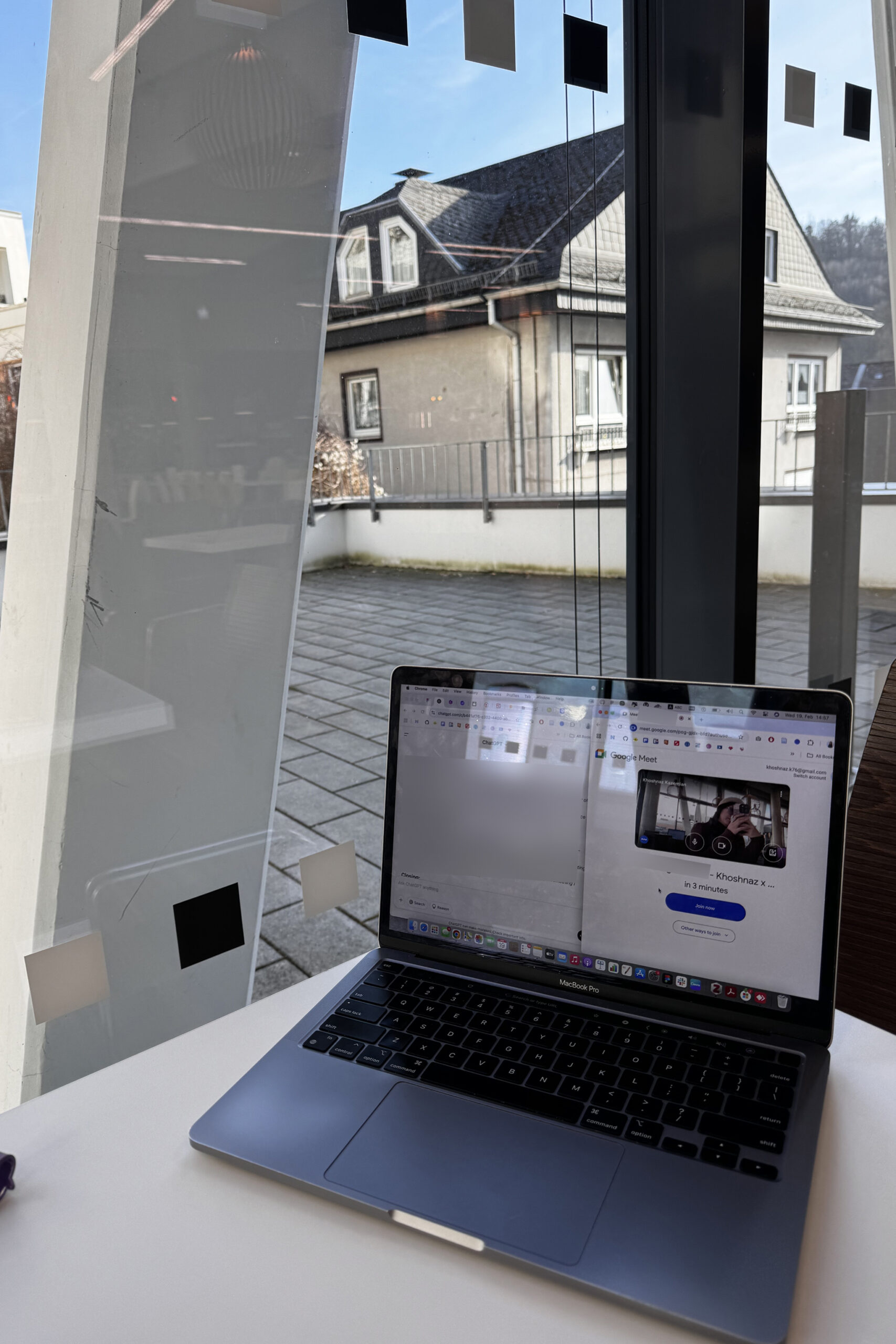
Some Admins Were Pragmatic Operators Who Needed Simplicity
They weren’t deeply technical. What mattered most was reliability, ease of setup, and clear monthly overviews they could quickly share with tenants or customers.
Others Were Efficiency-Driven Managers Looking for Control at Scale
They wanted automation, bulk actions, and detailed energy insights. Their focus was on managing multiple users, employees, or vehicles in the smoothest way possible.
A Third Group Focused on Guest Experience Above All Else
For them, EV charging was just one part of delivering a seamless guest journey. They expected smooth billing, easy-to-use staff tools, and minimal technical distractions.
👉 These insights revealed that our admins weren’t a single homogenous group, they had fundamentally different roles, goals, and success criteria.
Afterward, I Turned Raw Tickets and 18 Interview Transcripts into Clear Insights Using ChatGPT, Notion AI, and Miro to Prep for the Persona Workshop with the team
By this point, I had a mountain of messy information: over a year’s worth of support tickets and transcripts from 18 in-depth interviews. Before running a team workshop, I knew I had to translate all of this into a format that was clear, engaging, and easy for everyone to digest.
To do this
I combined AI-powered analysis tools like ChatGPT and Notion AI with Miro boards.
The AI helped me quickly cluster repeating patterns, surface recurring keywords, and summarize long transcripts into digestible themes.
From there, I used Miro to visually map these themes into categories such as daily workflows, major frustrations, and long-term expectations.
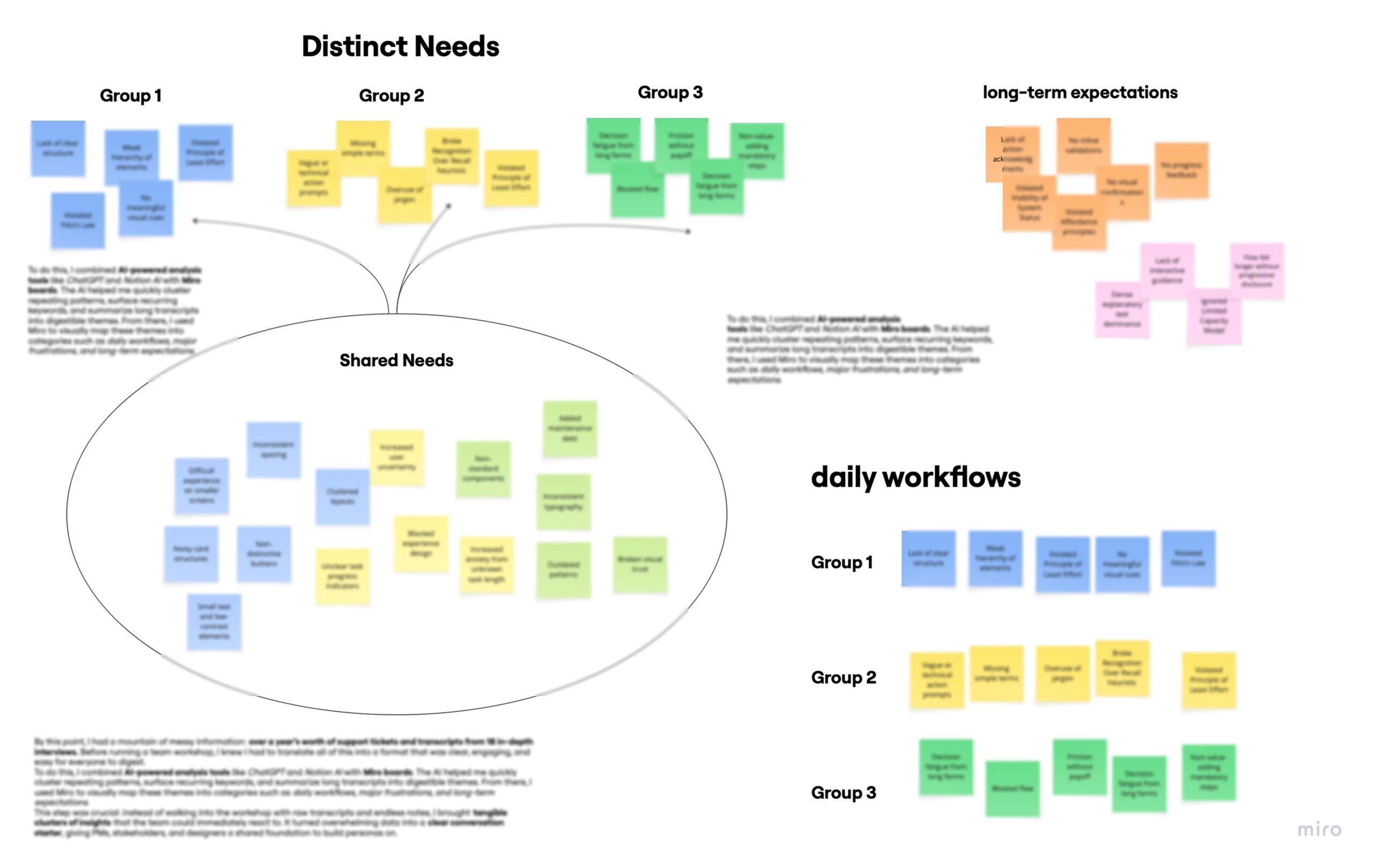
👉 Instead of walking into the workshop with raw transcripts and endless notes, I brought tangible clusters of insights that the PMs, stakeholders, and engineers could immediately react to.
🤓
Then I Facilitated Two Workshops with Team to Turn Our Miro Insights into Shared Understanding of Admins Persona and Clear Feature Priorities
For the First Workshop, My Goal Was to Align the Team Around Clear Personas and Their Needs
I designed and facilitated this workshop to bring clarity to the scattered insights. Using Miro, I laid out the differences and overlaps between admins, then steered discussions on which features counted as universal table stakes (like simple reporting) and which were role-specific (such as scheduling for fleets or guest billing for hotels).
During workshop;
I challenged assumptions, asked clarifying questions, and made sure every perspective was surfaced, but kept the group anchored to the data I had synthesized.
By the end, I defined and validated three personas
Now, Meet the People Who Shaped My Design Decisions (with a Focus on SME & Fleet Managers in This Case Study)

Meet Clara,
The admin behind tenants and residential houses.
Clara is 45, based in Hamburg, and manages EV charging for residential building. She's not deeply technical, but she’s the go-to person when tenants have charging issues, and needs tools that just work.
What matters to Clara (Hidden Due to NDA)
- Managing multiple user groups efficiently
- Clear billing for residents or customers
- Customizing data views to her needs
- Easy report exports for meetings
- Knowing exactly who charged where

This Is Who I Optimized For Here
Meet Markus,
The admin behind SME and Fleet charging chaos.
Markus Weber is 50, lives in Munich, and manages charging for his company’s employees and EV fleet. Efficiency is everything. He ensures the infrastructure works like clockwork for his team.
What matters to Markus (Hidden Due to NDA)
- Fast overview of sessions and usage
- Automating monthly billing by user group
- One-click session starts
-Managing many users with minimal clicks
- Avoiding dependency by fixing issues on his own

Meet Tom,
The admin behind hotel manager with guests.
Tom is 40, running a busy Berlin hotel with growing demand for guest EV charging. He’s not into technical hassle, just smooth operations and top-tier guest experiences during check-in and check-out peaks.
What matters to Tom (Hidden Due to NDA)
- Guests always find available stations
- Monitoring live sessions at a glance
- Simple tools for hotel staff use
- Clear billing tied to guest stays
- Reliable, stress-free charging flow
After Defining Personas,
I Mapped Their Needs Into a Role-Based Feature Matrix to Align Feature Priorities for the First Release
Before diving into solutions, we needed clarity on what each persona actually needed from their dashboard. So, I created a Role-Based Feature Matrix to map out the core features, access levels, and priorities for each group. This gave me a clear picture of where their workflows overlapped, and where they didn’t.
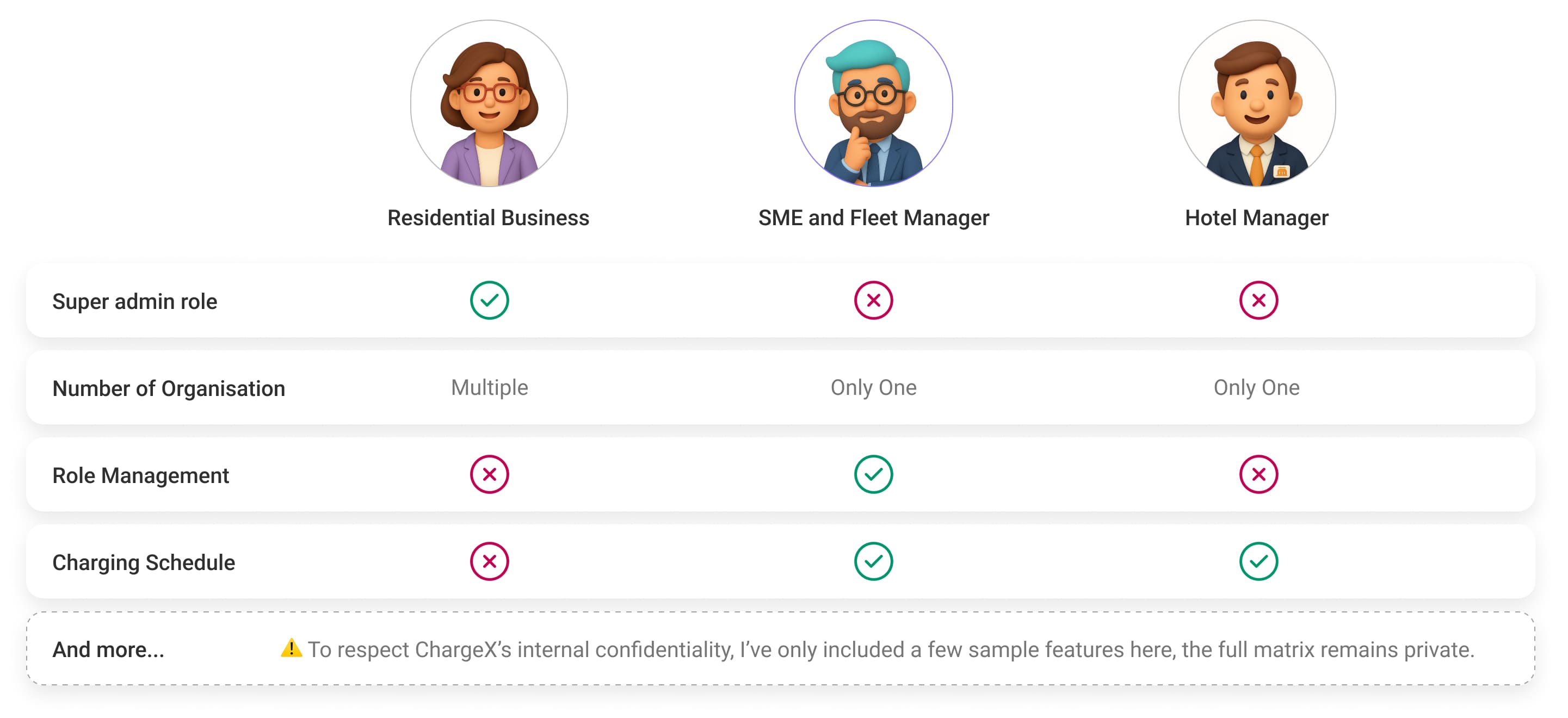
🧐💡
From the first workshop, I decided to prioritize SMEs and Fleet Managers as our core users to start, so this case study focuses on designing the dashboard around their needs.
And For the Second Workshop, I Prioritized Features with MoSCoW to Turn a Long Wishlist into a Focused Roadmap
With so many potential features on the table, I knew we needed clarity on what truly mattered for SMEs and Fleet Managers in the first release. I led a MoSCoW prioritization session, categorizing features into Must-Haves, Should-Haves, Could-Haves, and Won’t-Haves. By grounding the discussion in user pain points and business priorities, I made sure essentials like billing were treated as Must-Haves while less critical extras were deferred.
The outcome was a clear, defensible roadmap that aligned user needs with business goals and technical feasibility
This keeps us focused, avoiding scope creep, and giving me confidence in the design decisions that followed.
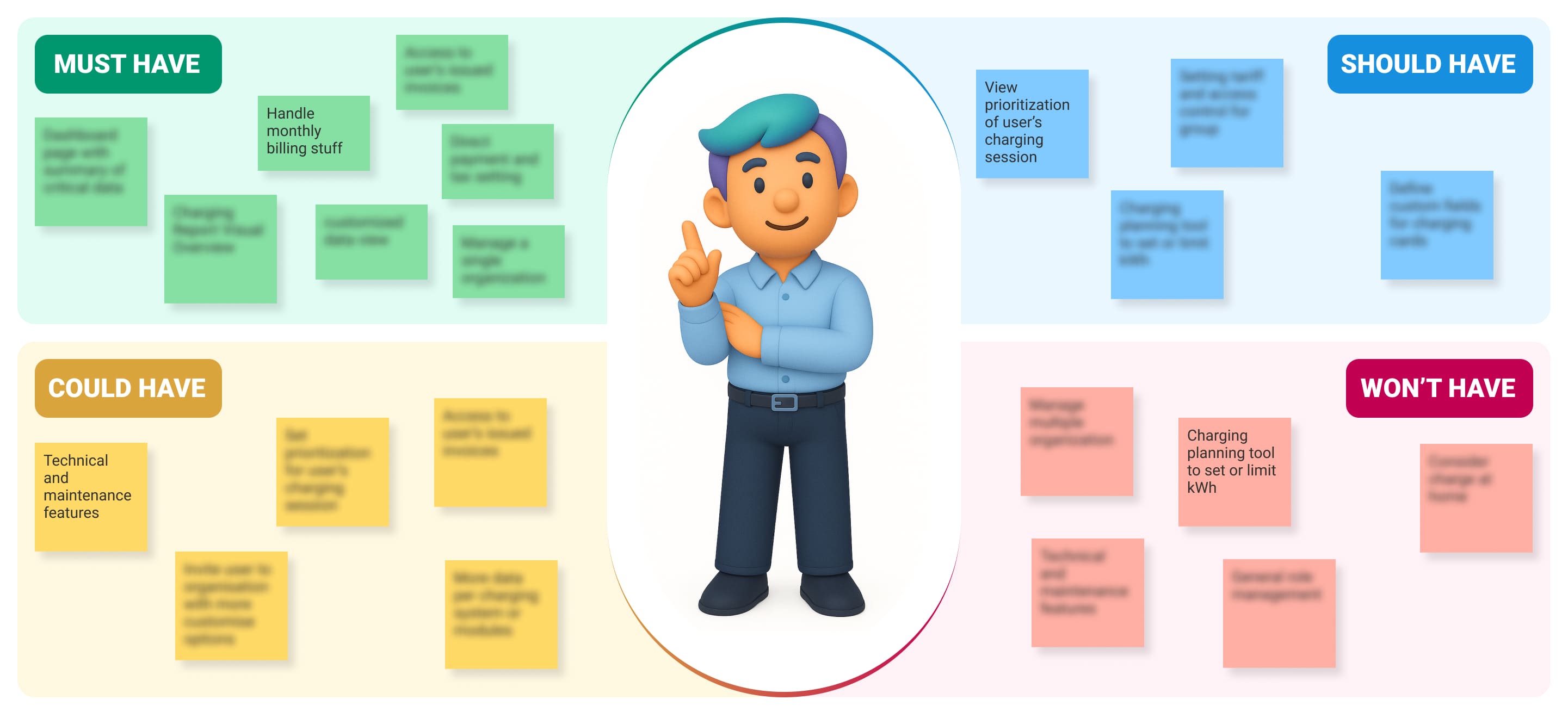
🤩
Now, with the must-haves for SMEs and Fleet Managers clearly prioritized, I am ready to kick off the big refactor of our six-year-old dashboard.
As the First Crucial Move, I Introduced a Real Dashboard to Give SMEs Instant Clarity on Their EV Operations For Fast Decision Making
🔴 From the start, I realized this persona didn’t just need more tools, they needed a clear perspective. Support tickets and interviews revealed their frustration with jumping between pages just to understand what was happening.
🟢 So, I designed the first real dashboard that the old system never had: a single control center that brings together charging station status though live map view, ongoing charging sessions, and key alerts at a glance. Now, instead of wasting time piecing things together, SMEs and Fleet Managers can instantly see what matters and act with confidence.
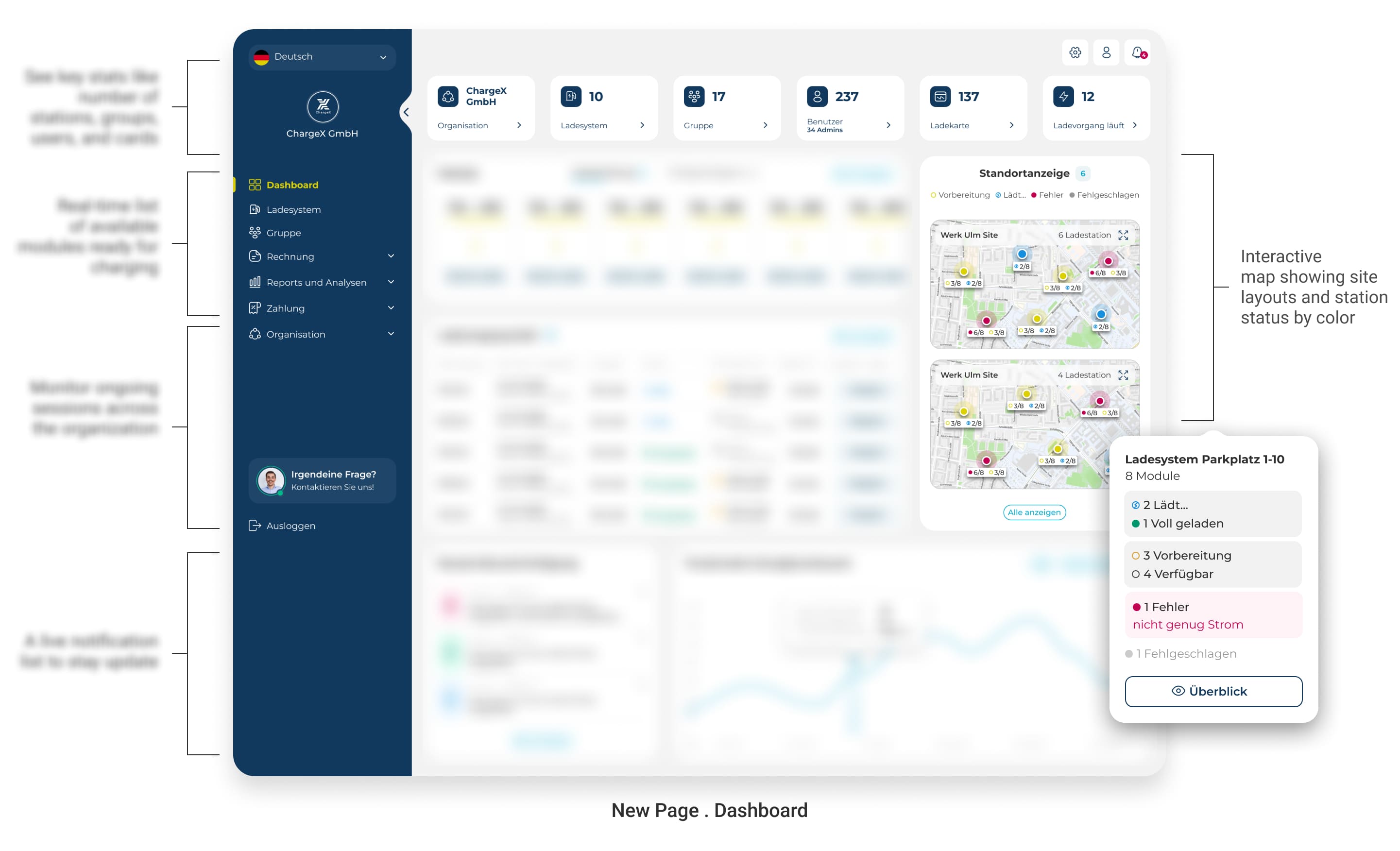
Then, I Tackled the Scaling Problems SMEs Faced With the Station List
🔴 One of the loudest complaints I uncovered was that the old station list simply didn’t scale. With no search, no filters, and no clear session details, admins wasted time scrolling through endless lines just to figure out who was charging and what was happening.
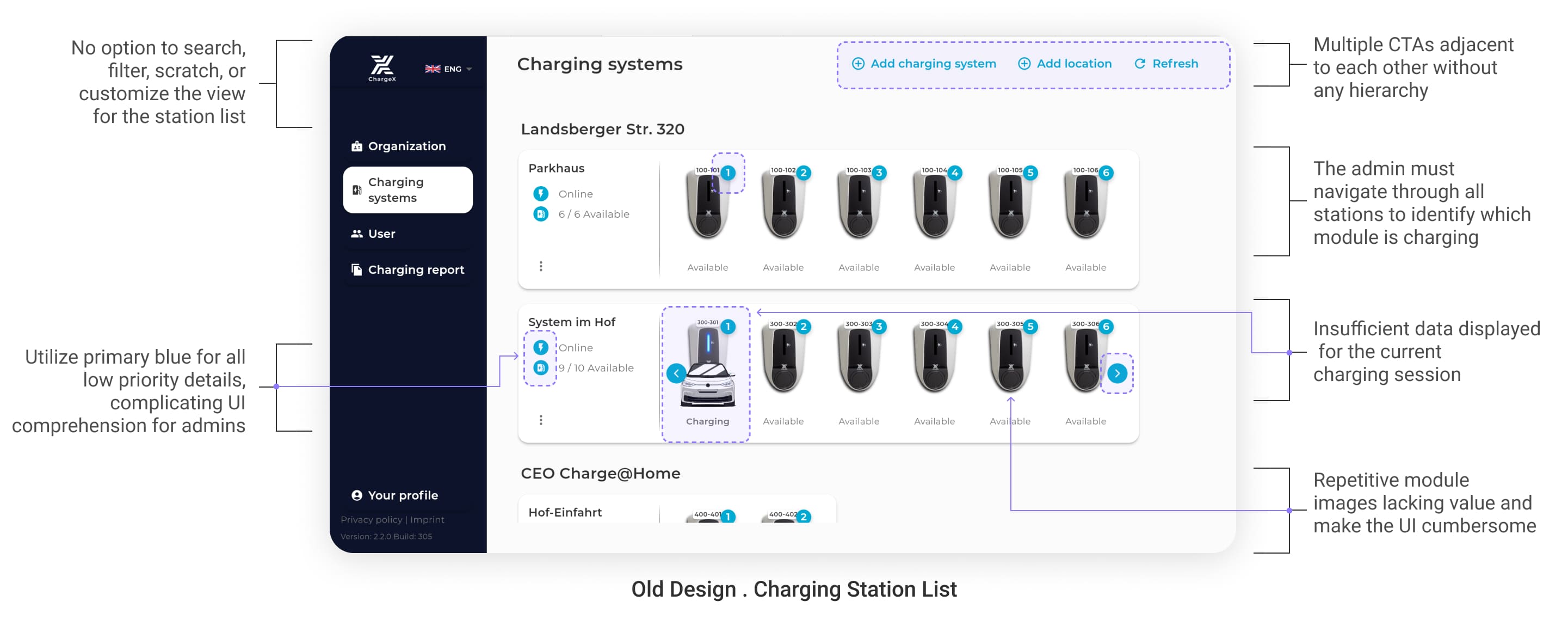
For This Section, I decided to Use Lovable for AI Rapid Prototyping to Run a Lean Test, That Turn My Assumptions Into Tested Insights
Instead of jumping straight into Figma and high-fidelity design, I wanted to validate my assumptions about how admins manage charging station lists. I had some ideas to make the lists scalable, easier to manage, and packed with the right data, but I needed quick feedback before investing weeks into design and dev.
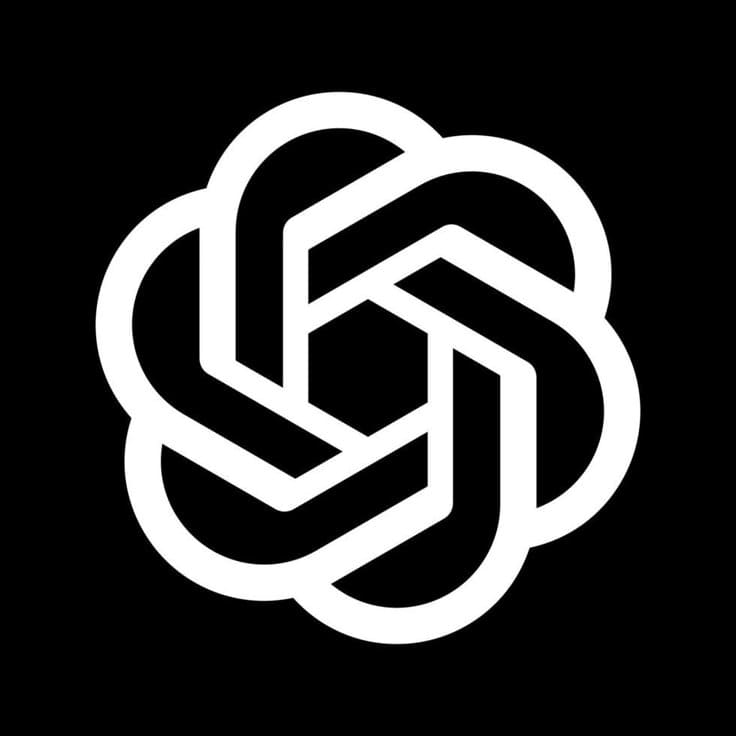
With a structured design spec I wrote in markdown (produced via my personalized GPT workflow), I fed it into Lovable. Within seconds, I had a working clickable prototype, fast, visual, and real enough to test with admins right away.
I put the prototype in front of 11 admins for a lean usability test. The speed of setup meant I could validate assumptions quickly and gather insights without wasting time polishing UI too early.
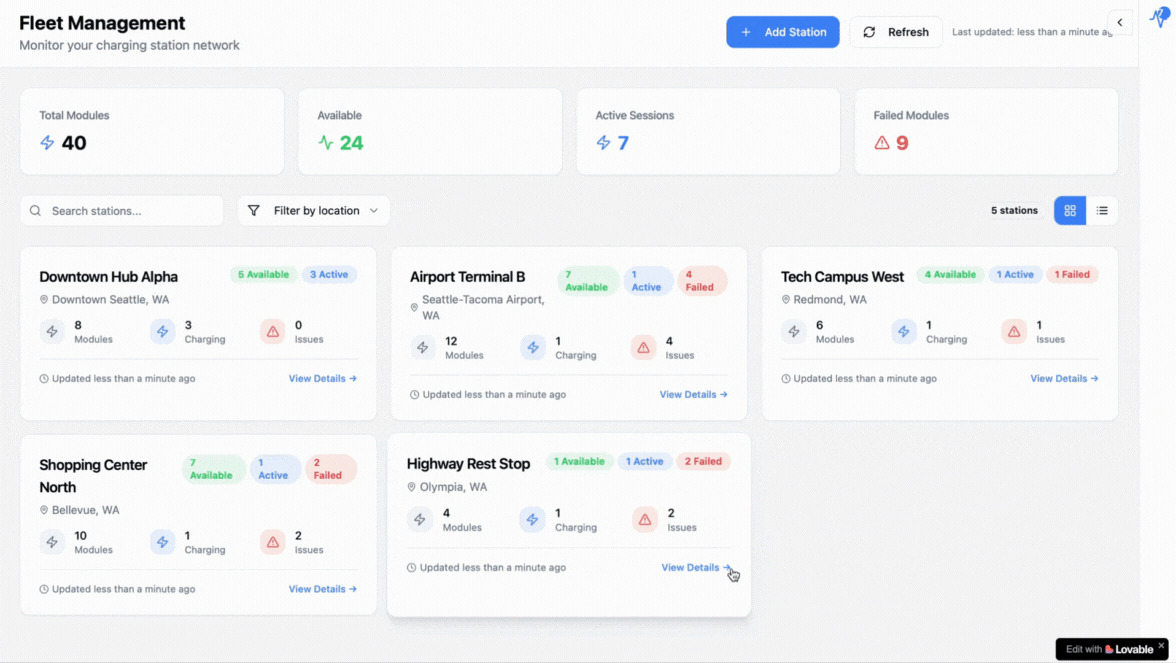
As a Result of Lean Testing, I Learned :
Admins strongly valued having a separate view for ongoing sessions only.
They preferred seeing module lists (with statuses) upfront for all stations, rather than clicking station by station.
They wanted charging card numbers tied to each session visible instantly.
Some labels and terms caused confusion and needed refinement.
✔️ So Finally, I introduced two view modes (table and card), built in search and sorting for long lists, and surfaced the essentials of every active session directly in the list.
With color-coded station states, admins can now instantly spot what’s available, active, or down, no more guessing, no more digging.
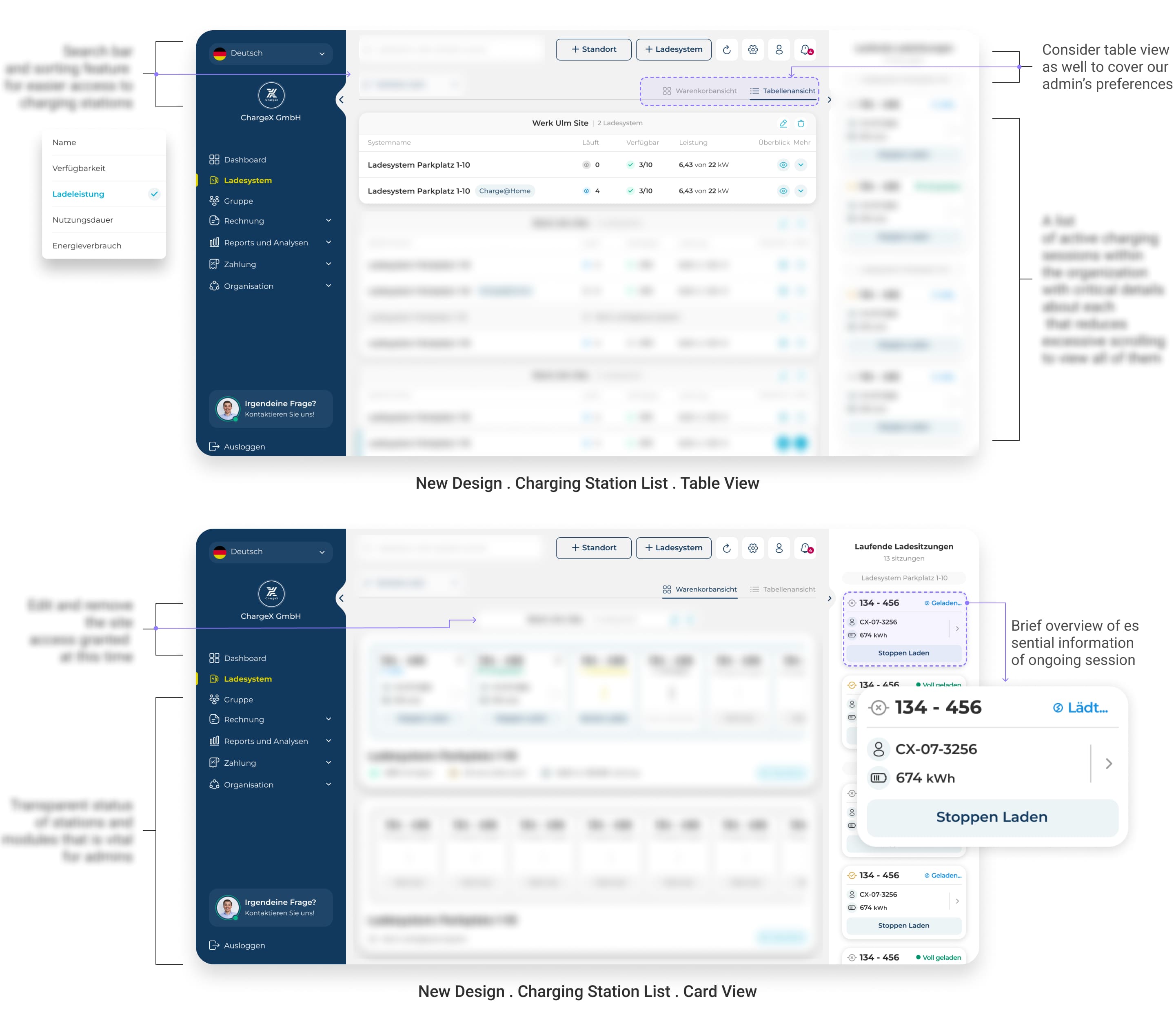
Afterward, I Took On the Messy Group & User Management Page to Fix Scalability Issues, and Introduced Monthly Billing as a Core Admin Tool
🔴 The old system mashed everything, groups, users, cards, into one endless page with no hierarchy. Admins told us it was confusing, time-consuming, and missing the billing tools they needed to actually run their business.
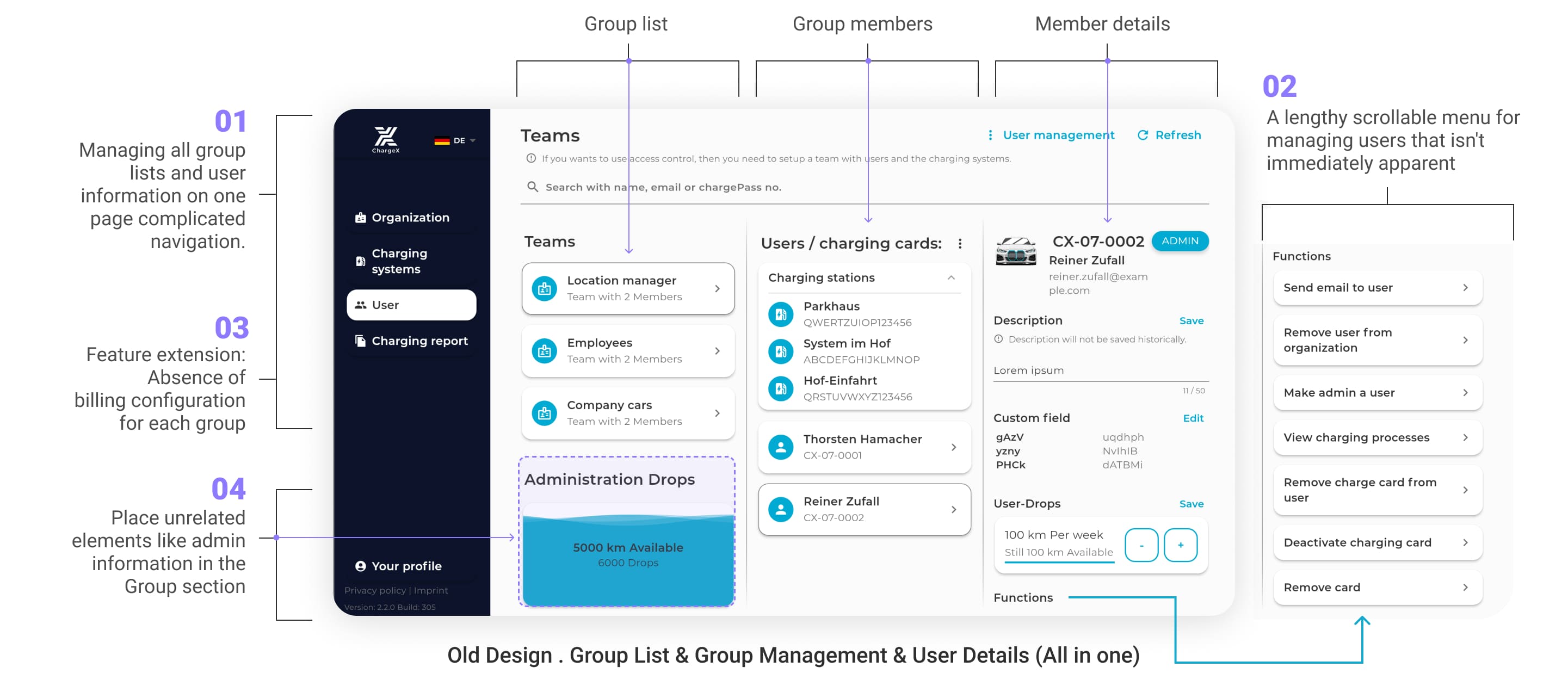
✔️ I Rebuilt Group Management Into a Clear, Searchable Hub Where Admins Can Assign Stations, Set Billing, and Manage Members Without the Old Confusion
I created a dedicated Group List page with structure, search, and sorting. Each group can now be managed with clarity: assign stations, set automated or manual monthly billing, and view members and cards in a clean, scannable way.
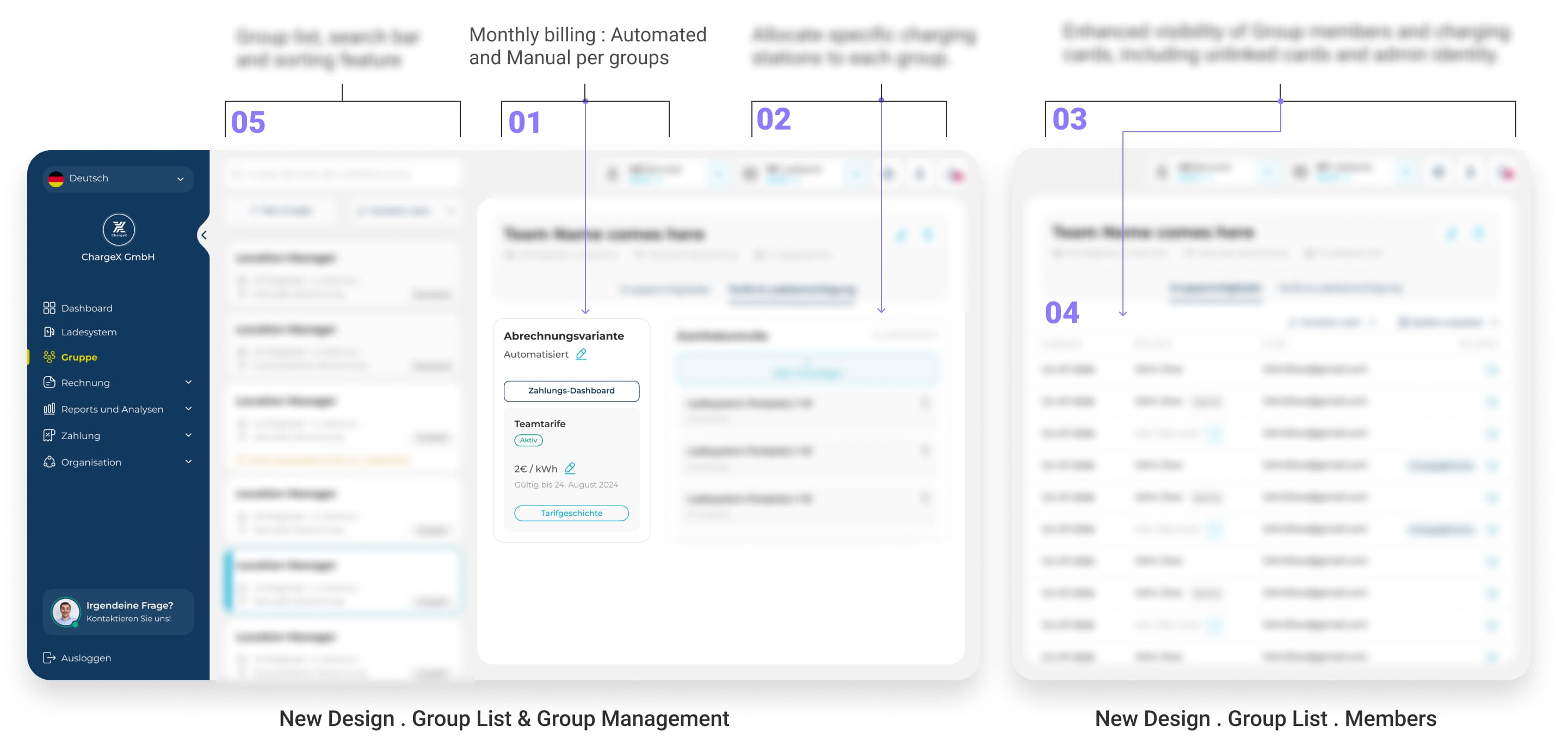
✔️I Also Transformed User Management Into a Focused Detail Page That Surfaces Cards, Sessions, Reports, and Billing, So Admins Take Action Instantly Instead of Digging Through Menus
Instead of a wall of unstructured links, I introduced a User Detail page. Admins can now manage multiple cards per user, monitor or stop sessions, generate reports, track monthly bills, and access quick stats at a glance. Every key action is surfaced through clear CTAs, not buried menus.
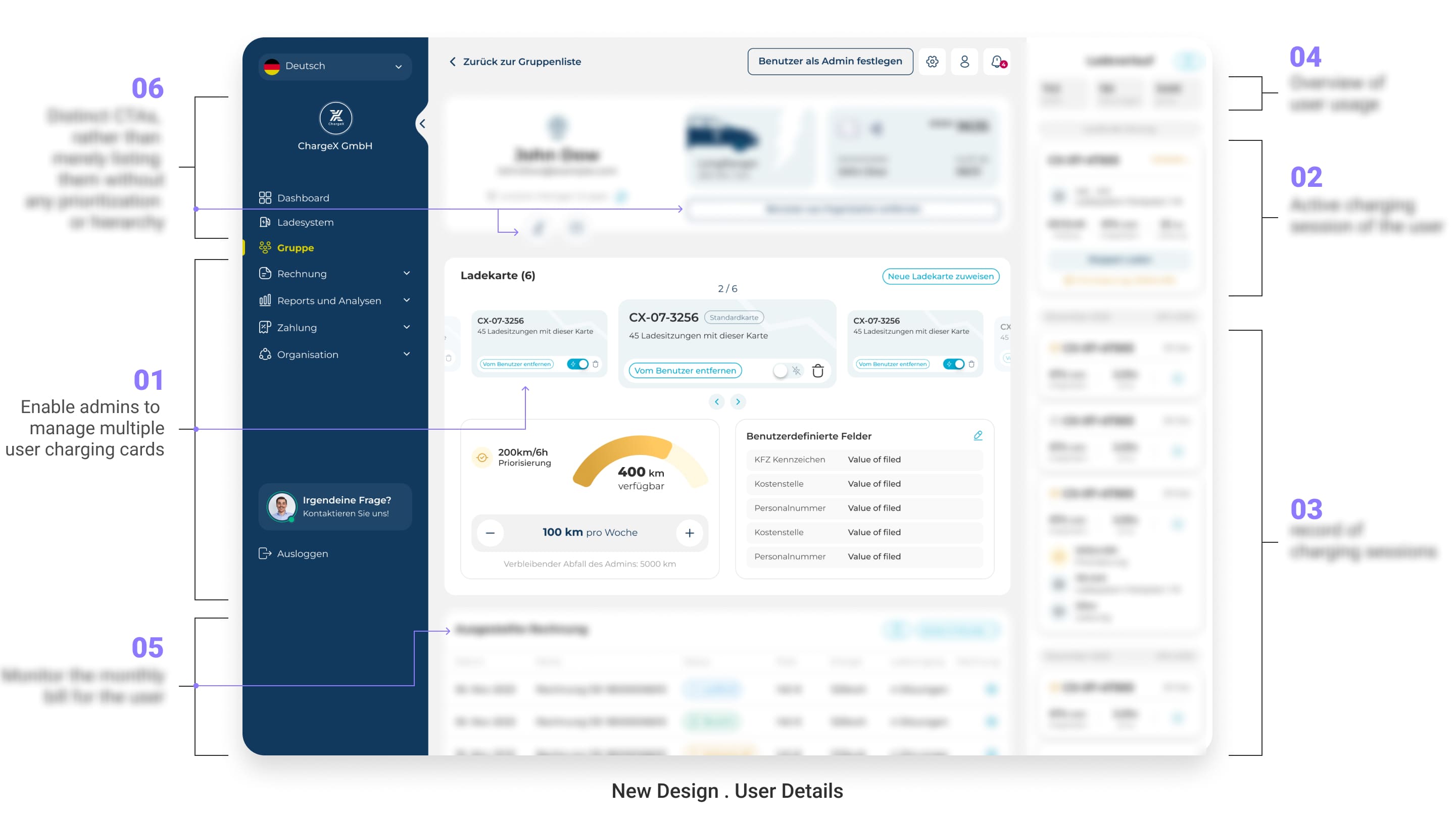
🥲
Ok, we fixed group management and introduced monthly billing as a new core feature, but was our mission done yet? Not quite.
I Also Had to Fix Profile Management That Felt Hidden and Confusing, to Make Upgrading to a Business Account Clear and Encouraging
🔴 The old profile was buried in a scrollable pop-up that didn’t fit admins’ mental model of a dashboard. Even basic actions like updating profile settings were hidden below the fold. I stepped in to redesign it because admins needed a profile space that was not only visible and trustworthy but also the natural entry point for upgrading to a business account.
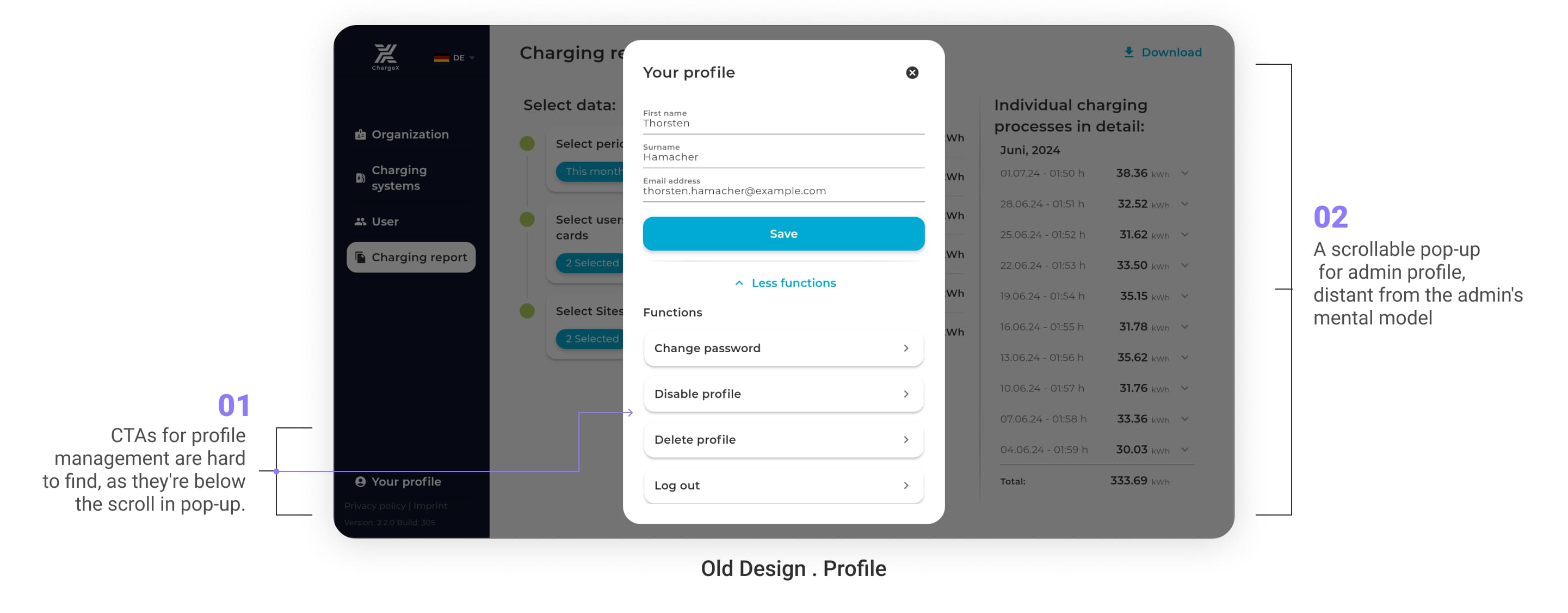
Then, I Untangled the Organization Page That Mixed Unrelated Tools, to Create a Logical and Trustworthy Structure
🔴 In the old setup, the organization page threw everything together with no logic: important CTAs blended with minor actions, upgrade buttons gave no reason to upgrade, and related tools like Drop Management were misplaced in other sections. I decided to restructure it because admins needed clarity and a logical hierarchy to manage their business with confidence.
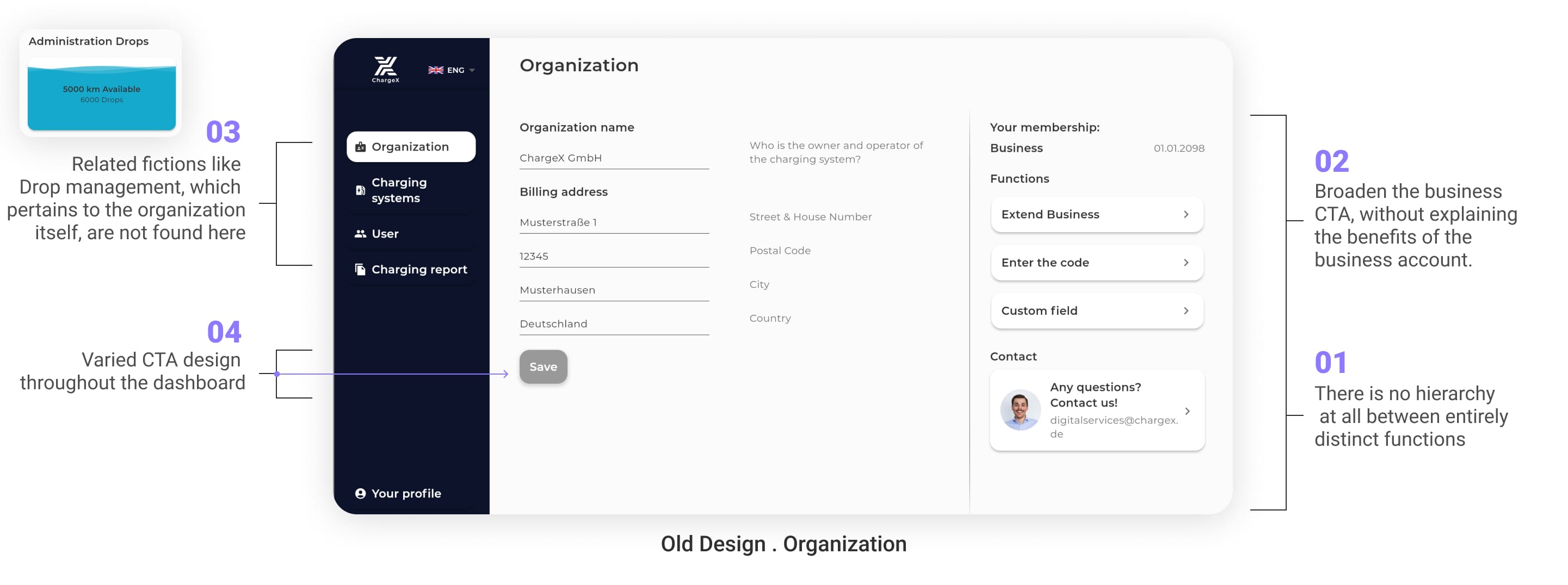
✔️ Finally, I Brought Profile and Organization Together, so Admins Can See Their Plan, Upgrade Easily, and Manage Drops Where They Belong
My solution was to merge profile and organization into one clear, intuitive hub. I designed it to surface what truly matters: clear account type and upgrade benefits, correctly placed Drop Management, financial insights powered by monthly billing, and key stats at the top for fast decision-making. By connecting the dots, I turned two confusing spaces into a single business-focused area that helps admins act with clarity instead of frustration.
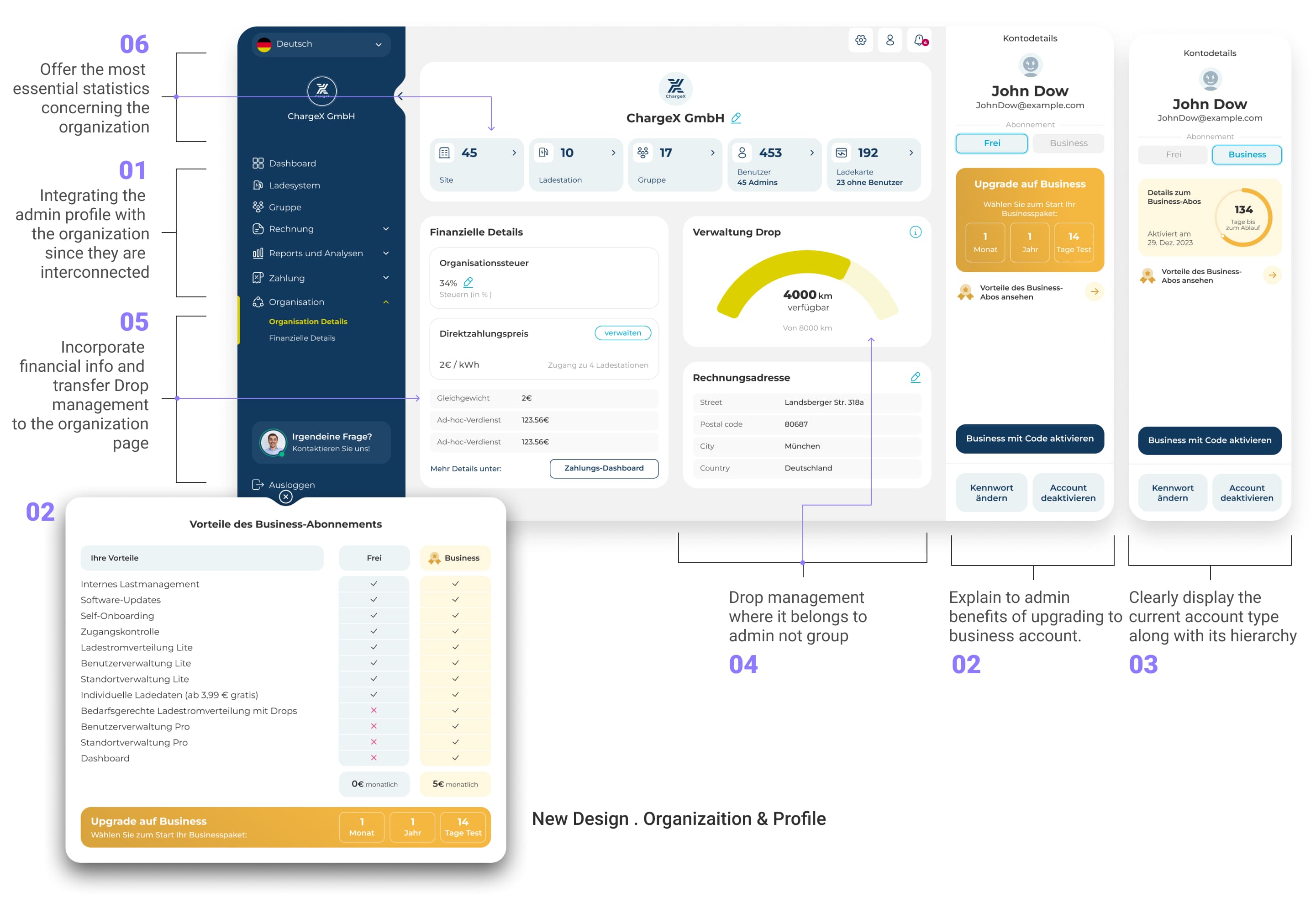
🥲
Another major need that surfaced during research was SMEs’ reliance on reports to truly understand their organization, so it is time to fix the broken reporting experience.
So, I Focused on Fixing Reports Because SMEs Couldn’t Quickly Filter, Preview, or Trust Their Exports
The old reporting section was messy and unhelpful: admins had no quick filters, no previews, and confusing UI where CTAs and tags looked the same. With nothing but raw numbers and no visuals, exports felt like a gamble. Instead of unlocking insights, the tool left SMEs frustrated and ignoring valuable data they needed for decisions.
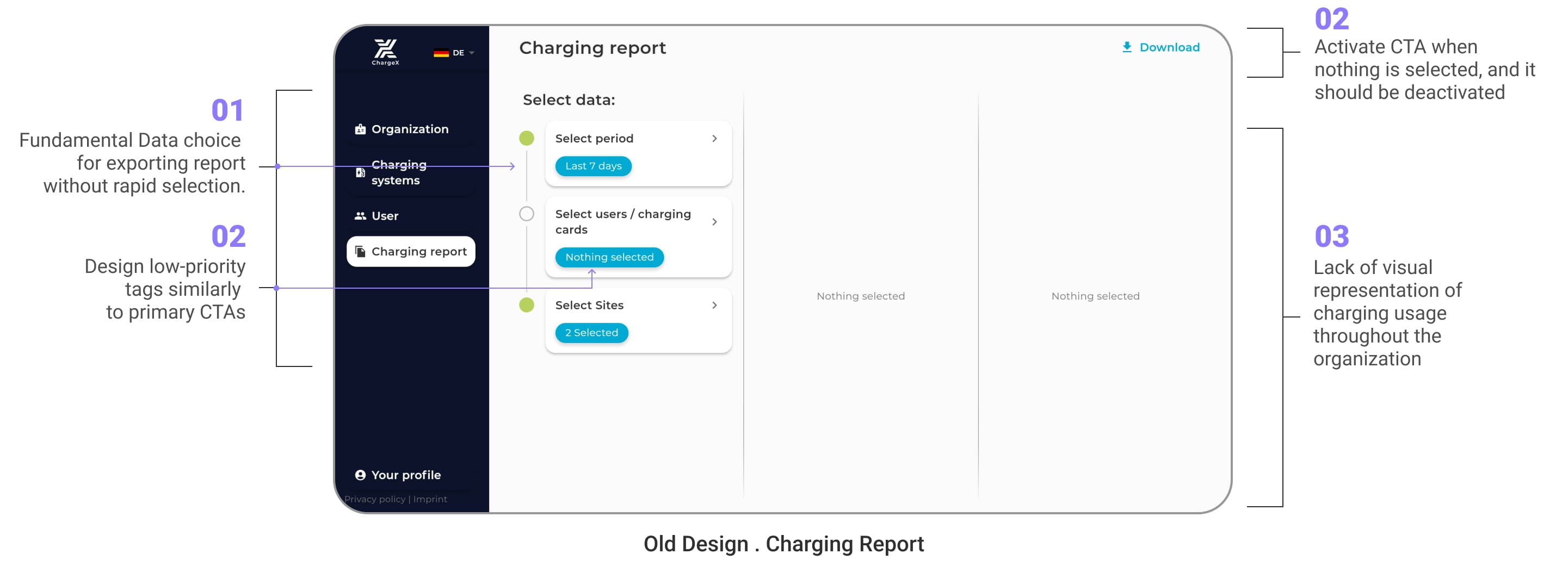
✔️ To fix this, I split the reporting section into two focused tabs to Give SMEs Both Control and Clarity
In the First Tab, I Gave SMEs Live Previews and Quick Filters So They Knew Exactly What They Were Exporting
Previously, admins exported data blind, with no preview, no filters, and no clear control. I redesigned the flow to show a live preview before exporting, added quick time selectors for speed, and let them pick the format that matched their workflow. This turned exporting from trial-and-error into a fast, reliable process that SMEs could depend on daily.
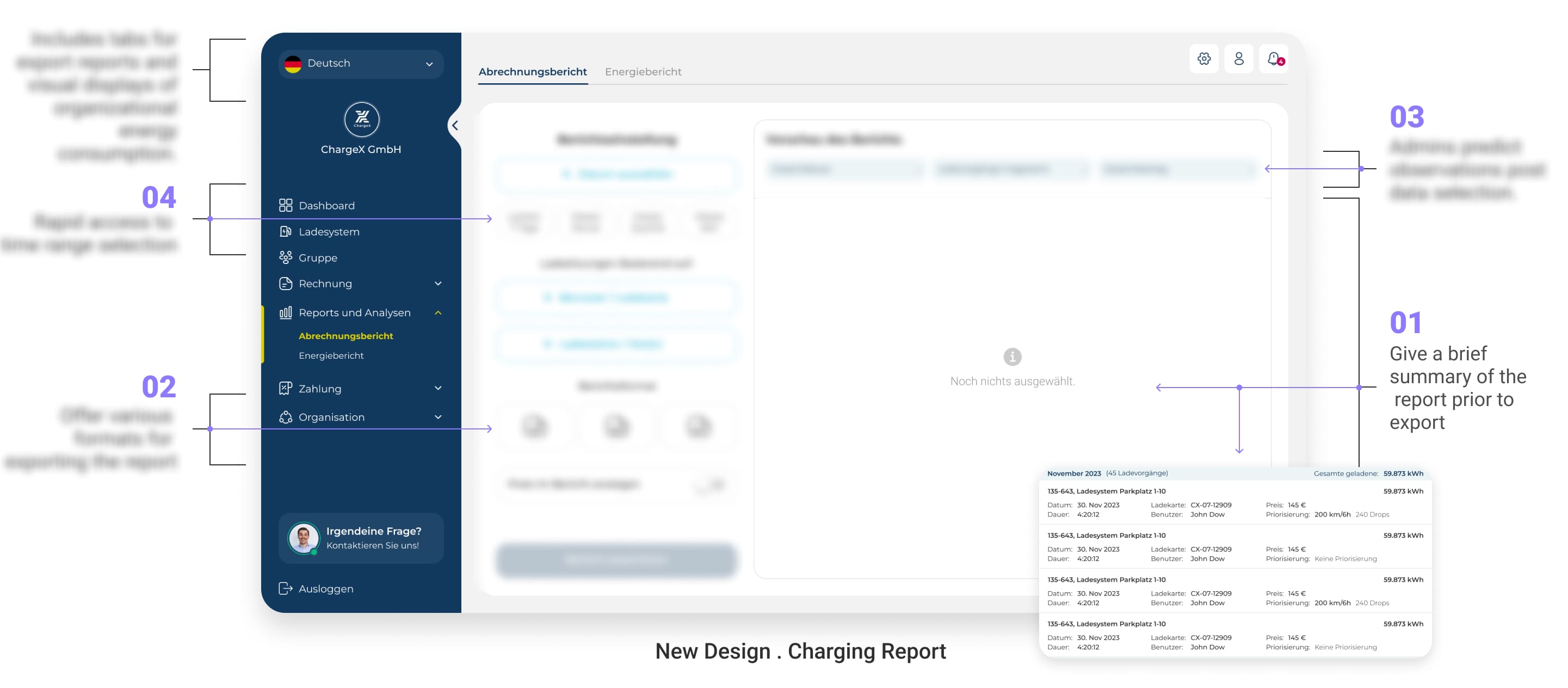
In the Second Tab, I Turned Raw Numbers Into Clear Visual Insights
Raw spreadsheets slowed SMEs down and buried important patterns. In the second tab, I introduced visual reports with charts that reveal usage trends, energy flows, and activity at a glance. Instead of deciphering endless tables, admins can now spot problems, track performance, and make confident decisions instantly.
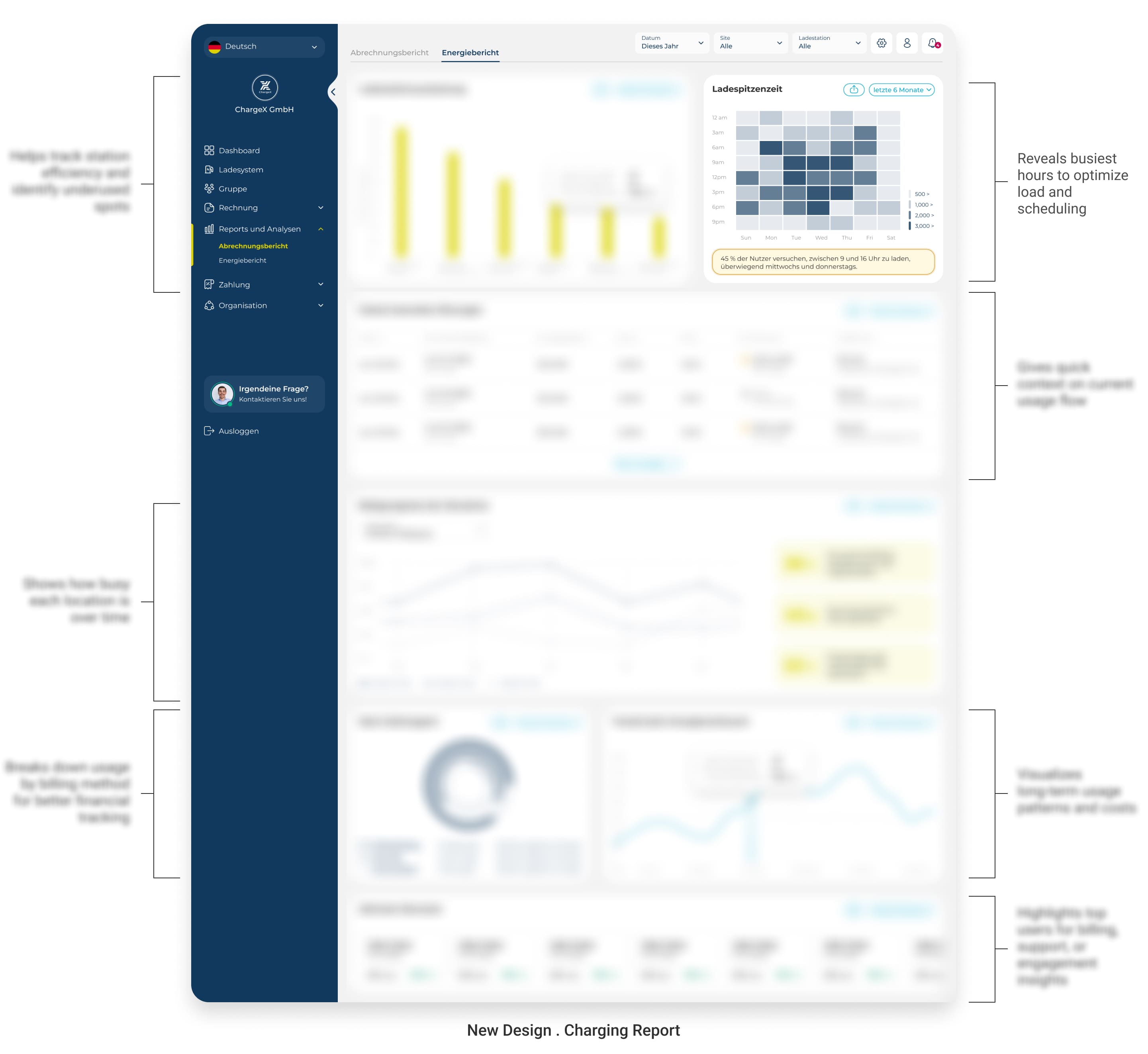
👩💻
Finally, I Decided to Put the New Dashboard in Front of Real SMEs Before Development!
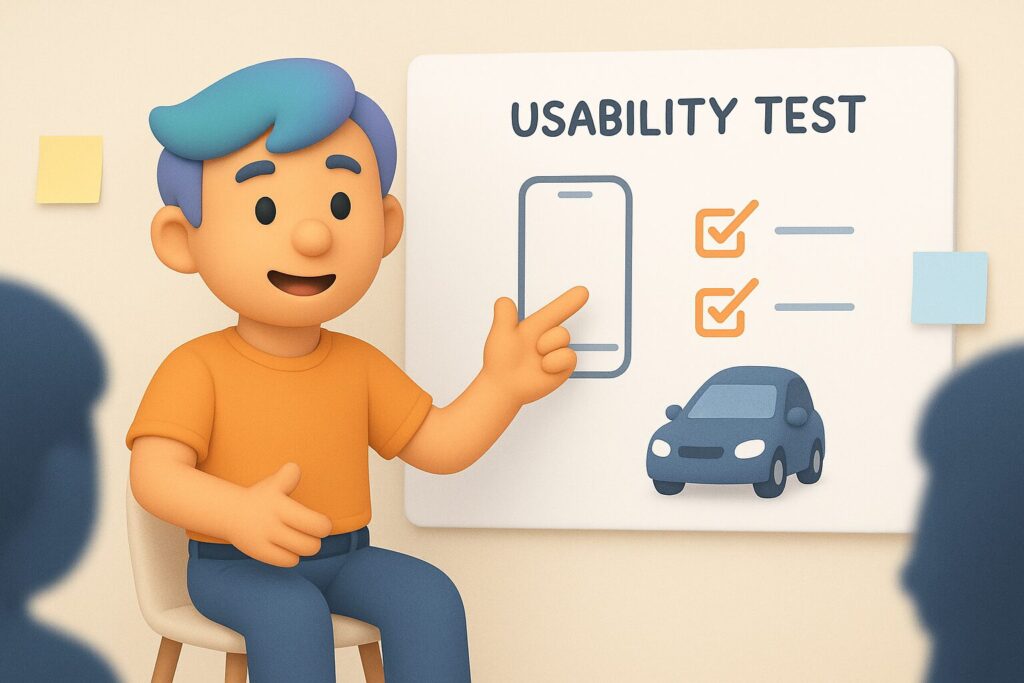
So, For the most critical admin journeys, I ran unmoderated usability testing with Maze, using a clickable Figma prototype.
Mission 1
→
Report & Insights Journey
→
Path Exploration Test
Mission 2
→
Station List & Stop Session
→
Task Completion Test
Mission 3
→
Add New Station
→
Path Exploration Test
Mission 4
→
Monitor Ongoing Sessions
→
First Click Test Test
Mission 5
→
Upgrade to Business
→
Path Exploration Test
All of these missions gave me constructive insights that shaped design improvements.
👉 But to save space, I’ll walk you through the most critical one: Mission 6
Mission 6
→
New Monthly Billing Feature
→
A/B placement testing
I Wanted to Confirm Two Points Regarding This New Monthly Billing Feature:
Where this feature should live in the team management flow
and how clearly admins understand it.
👇
To do this, I ran a mix of A/B placement testing and a New Feature First Impressions test with 12 SME admins using Maze.
Through A/B Testing, I Learned Admins Prioritize Daily Member & Card Management, So I Moved Monthly Billing to the Second Tab Where It Fits Their Workflow
In this A/B test, I showed SMEs two variations: billing placed in the first tab versus in the second.
Heatmaps and click patterns revealed that admins consistently clicked into a team expecting to first manage members and cards, the tasks they handle daily. Billing, while important, was a less frequent action. With a clear label, admins overwhelmingly preferred it in the second tab, freeing the first tab for daily operational needs. This evidence helped me make a confident decision on the final layout.
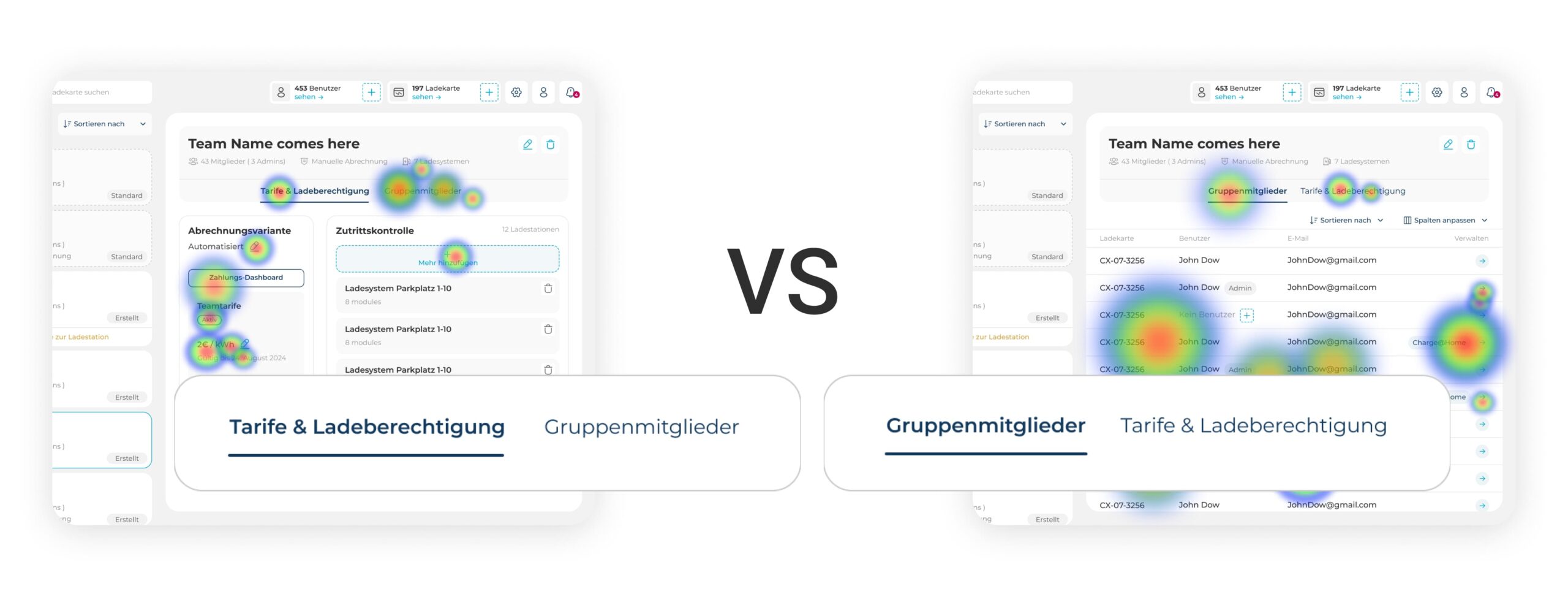
74% of Admins Clicked Teams Just to Check Billing, So I Made Billing Type and Admin Count Instantly Visible on Every Team Card
The usability test revealed that most admins (74%) didn’t enter team cards to manage details firs, they entered just to confirm the billing type.
This showed me that hiding billing inside tabs created unnecessary clicks. On top of that, several admins stressed that seeing only the number of members wasn’t enough, they needed to know the number of admins as well, since admin availability directly affects how smoothly a team operates. By surfacing both billing type and admin count directly on the team card, I reduced friction and made critical context available before admins even clicked.
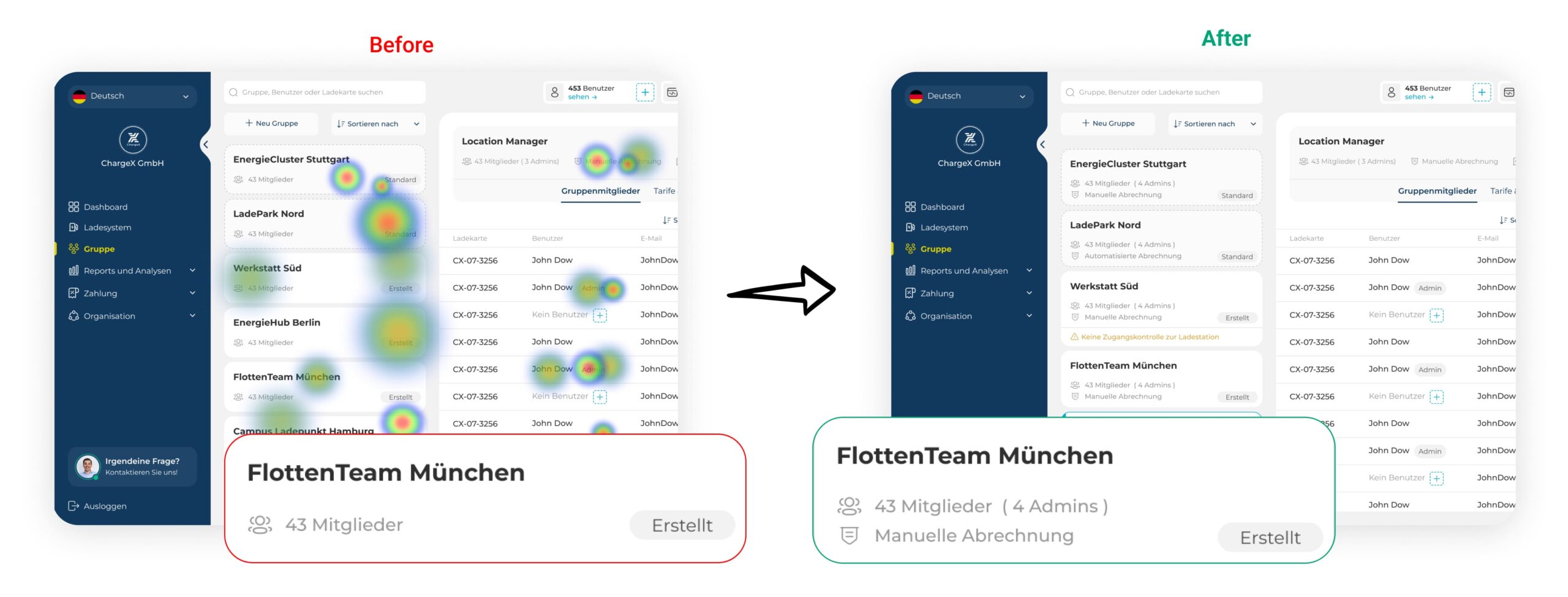
Admins Struggled to Choose Between Manual and Automated Billing, So I Added Clear Explanations to Remove Confusion
In the usability test, I saw that several admins hesitated when asked to assign a billing type. What I thought was self-explanatory turned out to be unclear in practice
many weren’t sure whether manual or automated billing was the right choice for their teams. Since this is a new feature with real financial impact, the risk of misconfiguration was high. To solve this, I added short, plain-language explanations under each option (e.g., Automated → invoices generated monthly without admin effort). This small addition gave admins the confidence to make the right choice without second-guessing.
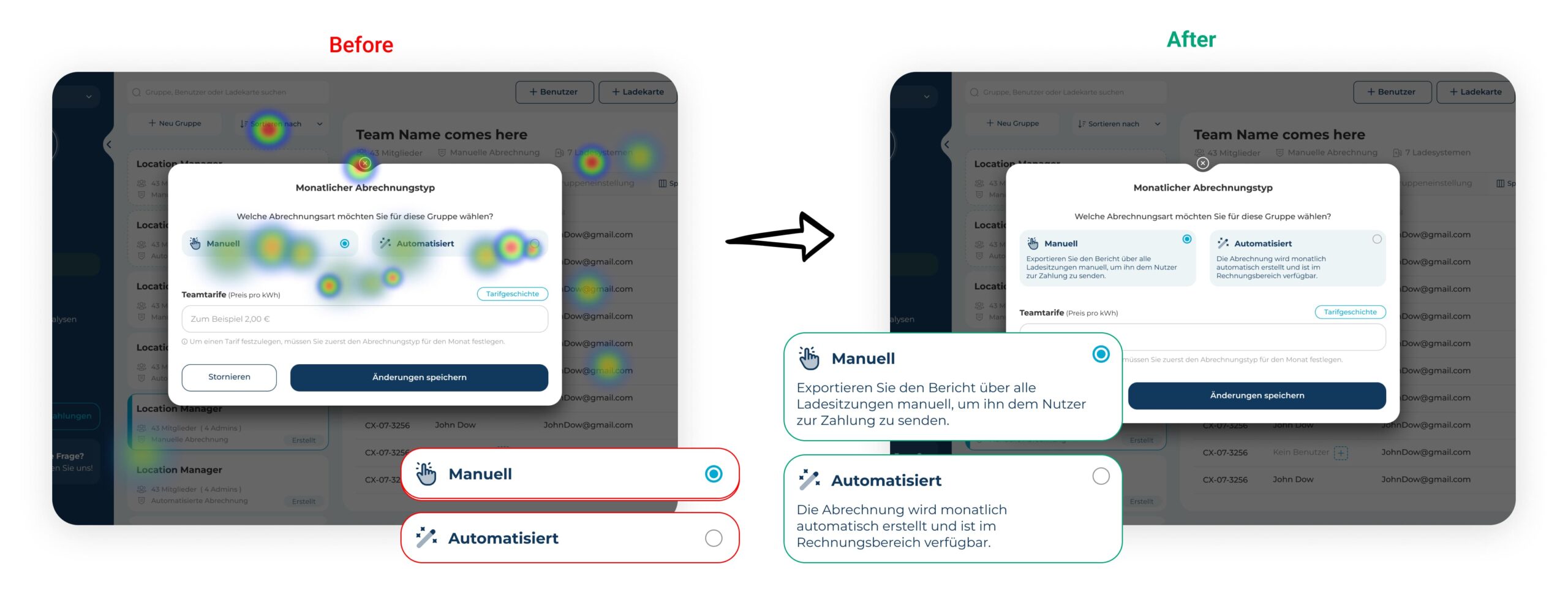
Admins Found Stripe Redirects Frustrating, So I Designed a Native New Payment Section Inside the Dashboard
During usability testing, admins consistently flagged the Stripe redirect as an unnecessary extra step. While it technically gave them access to payment data, it broke their workflow and forced them out of the ChargeX dashboard.
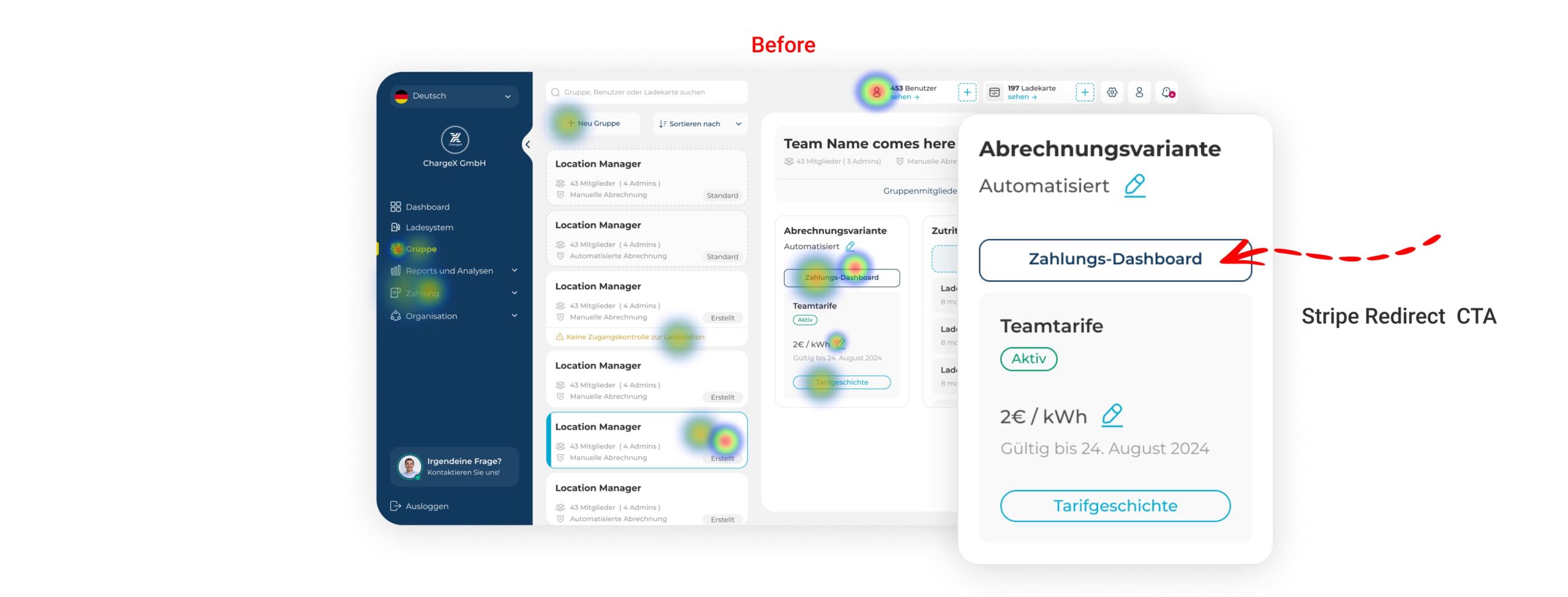
Acting on this, I created a dedicated Payments section where admins can see all transactions, track payout details, and adjust payment settings without leaving the platform. This change turned payments from an external dependency into a native, trusted part of the admin experience.
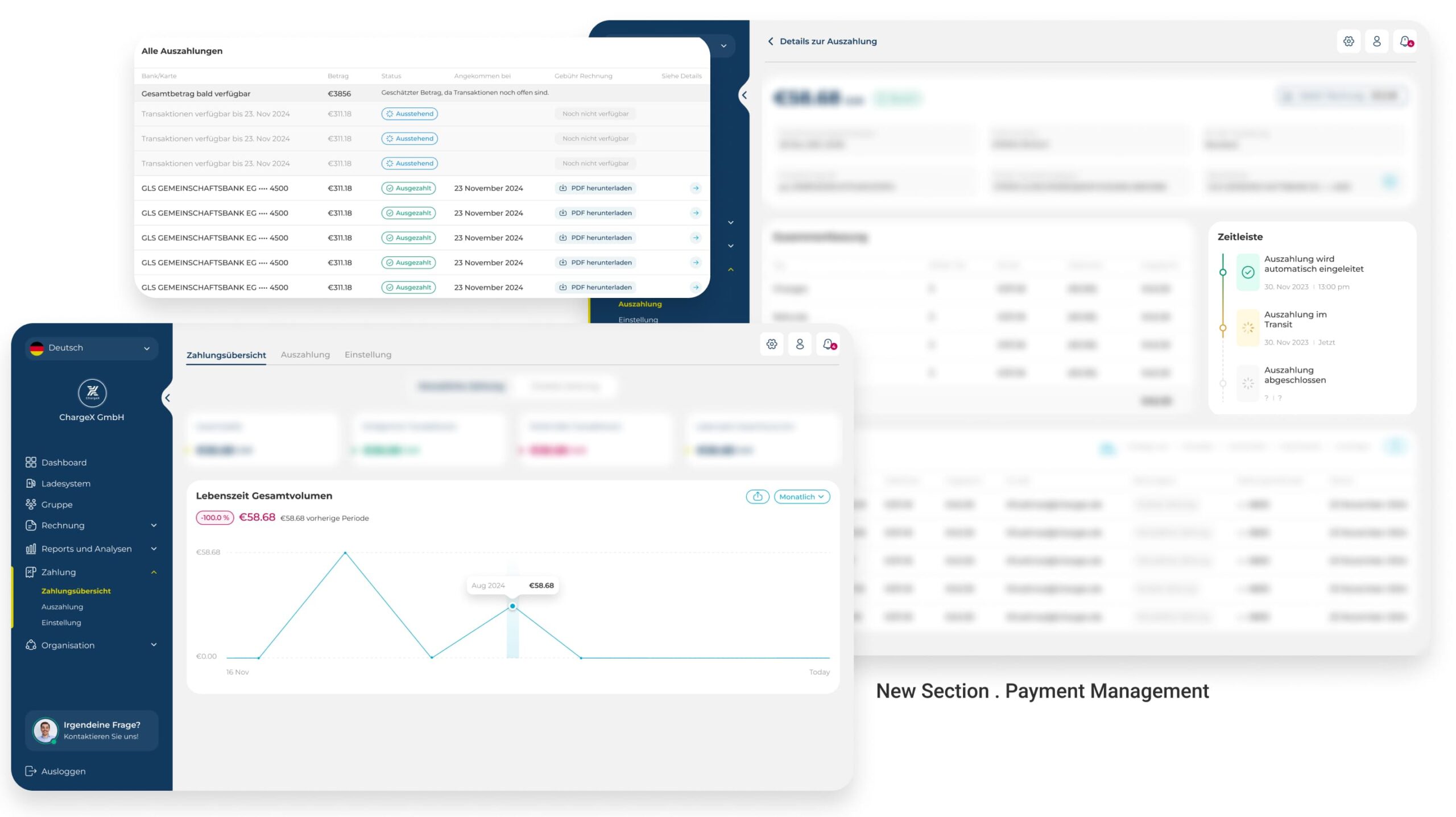
🤓
Where we are now, and what’s still ahead ?
In This Case Study, I Designed the Must-Have Features for SMEs, and I’m Already Shaping Next Iterations for All Three Personas
This case study focused on the Must-Have features and a handful of Should-Haves for our priority persona: SME and Fleet Managers. These were the flows we committed to for the first release, guided by the MoSCoW roadmap.
But with such a complex system designed for three distinct personas., this is only the beginning. I’m already working on wireframes for upcoming features that climbed the priority list after MVP testing — features that will complete the bigger picture in future iterations.
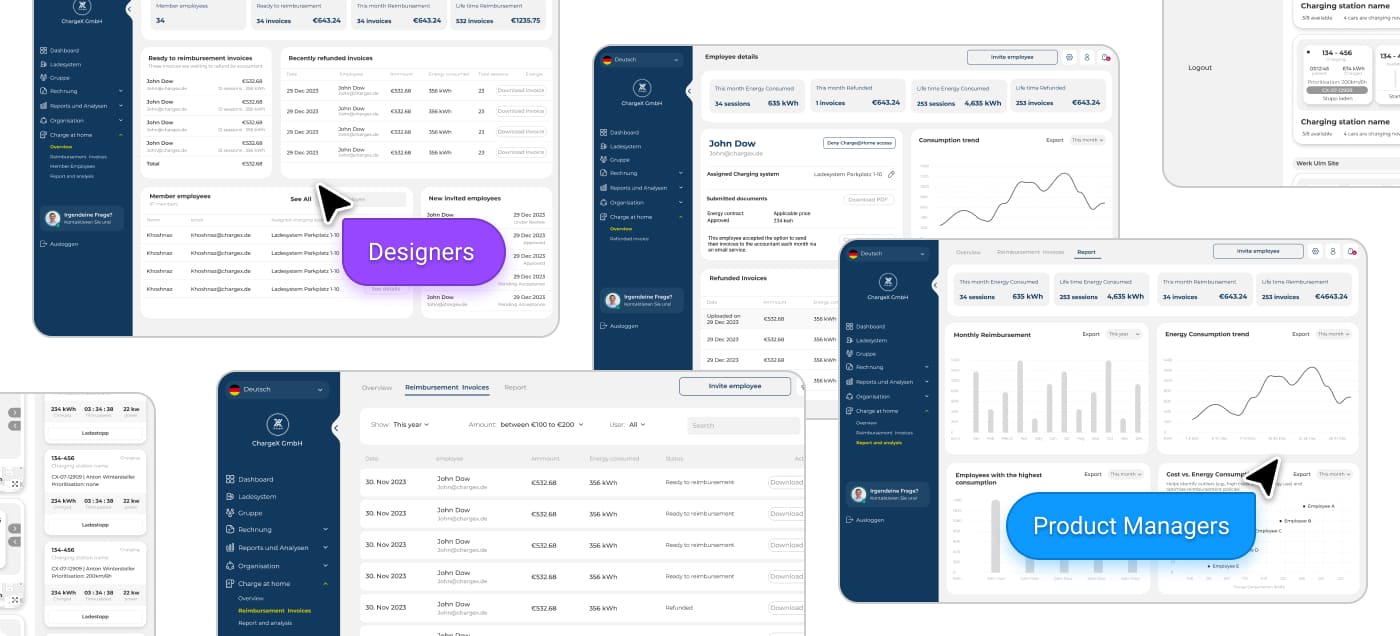
From My Research and Testing, I Can Already See the New Dashboard Will Unlock New Customer Segments and Help Admins Meet All Their Needs Faster
While the new dashboard is still under development, everything we’ve learned so far, from research to early testing, points to big impact.
Here are some projected impacts:
📈 Opens new customer segments by delivering dashboards tailored to the distinct needs of SMEs, Fleets, and Hotels
🧩 Equips the sales team with persona-specific solutions that make Chargex’s value proposition clearer and harder to compete with
⏱️ Cuts wasted time for admins by streamlining workflows, turning hours of manual searching into minutes of confident action
🤝 Enables self-sufficiency so admins can complete core tasks without relying on customer support interventions
😀 Raises satisfaction and trust with interfaces that feel intuitive, transparent, and aligned with real admin priorities
🚀 Builds a scalable foundation that positions ChargeX to evolve with new features and stay ahead in a rapidly growing EV market
👀
Take a look at behind the scenes!
I Built a Scalable Design System with Smart Components and Variants to Ensure Consistency Today and Flexibility for ChargeX’s Future
While working on the ChargeX admin dashboards, I wasn't just focused on making things look good for today.
Behind the scenes, I spent time building a scalable design system, setting up smart components, variants, and clear foundations that could grow with ChargeX's future needs.
This approach made it way easier to maintain consistency across the dashboards, reduced chances of errors, and gave developers a much cleaner handoff for faster implementation.
